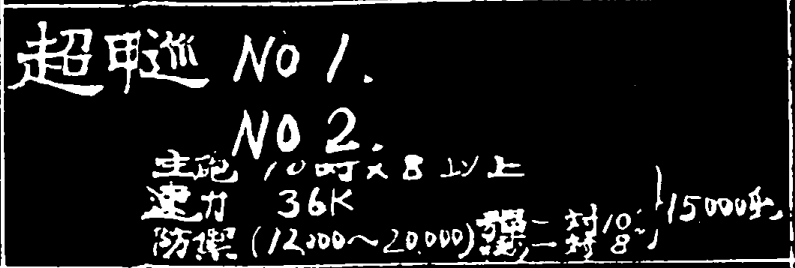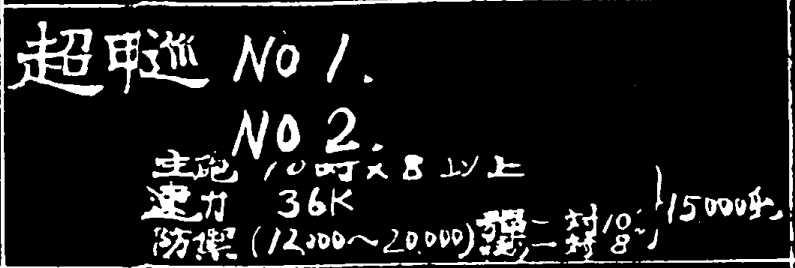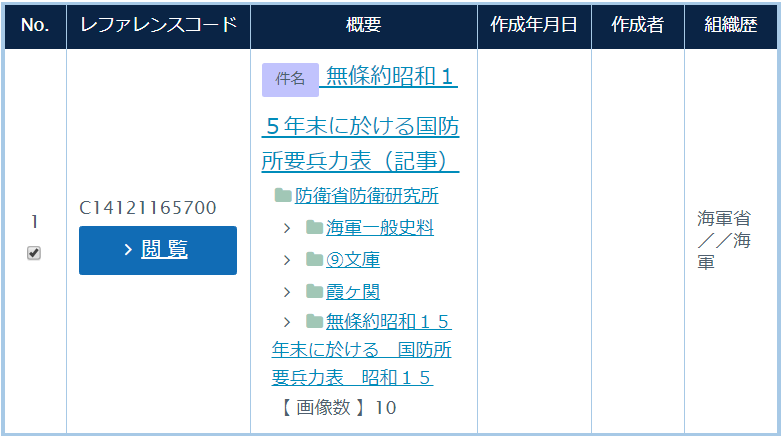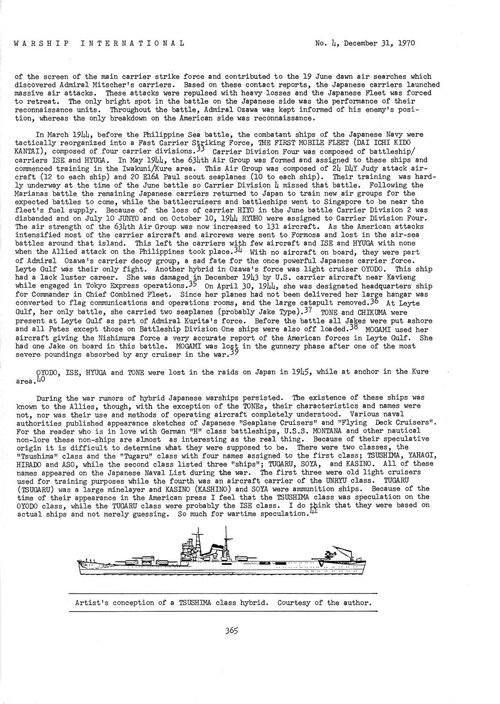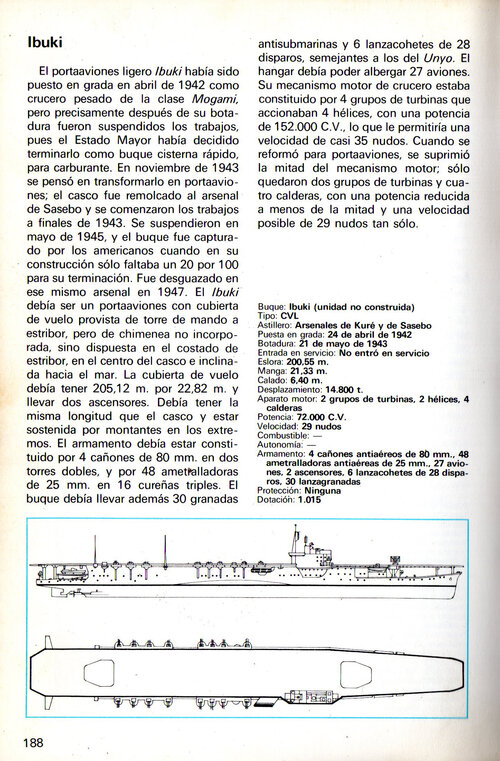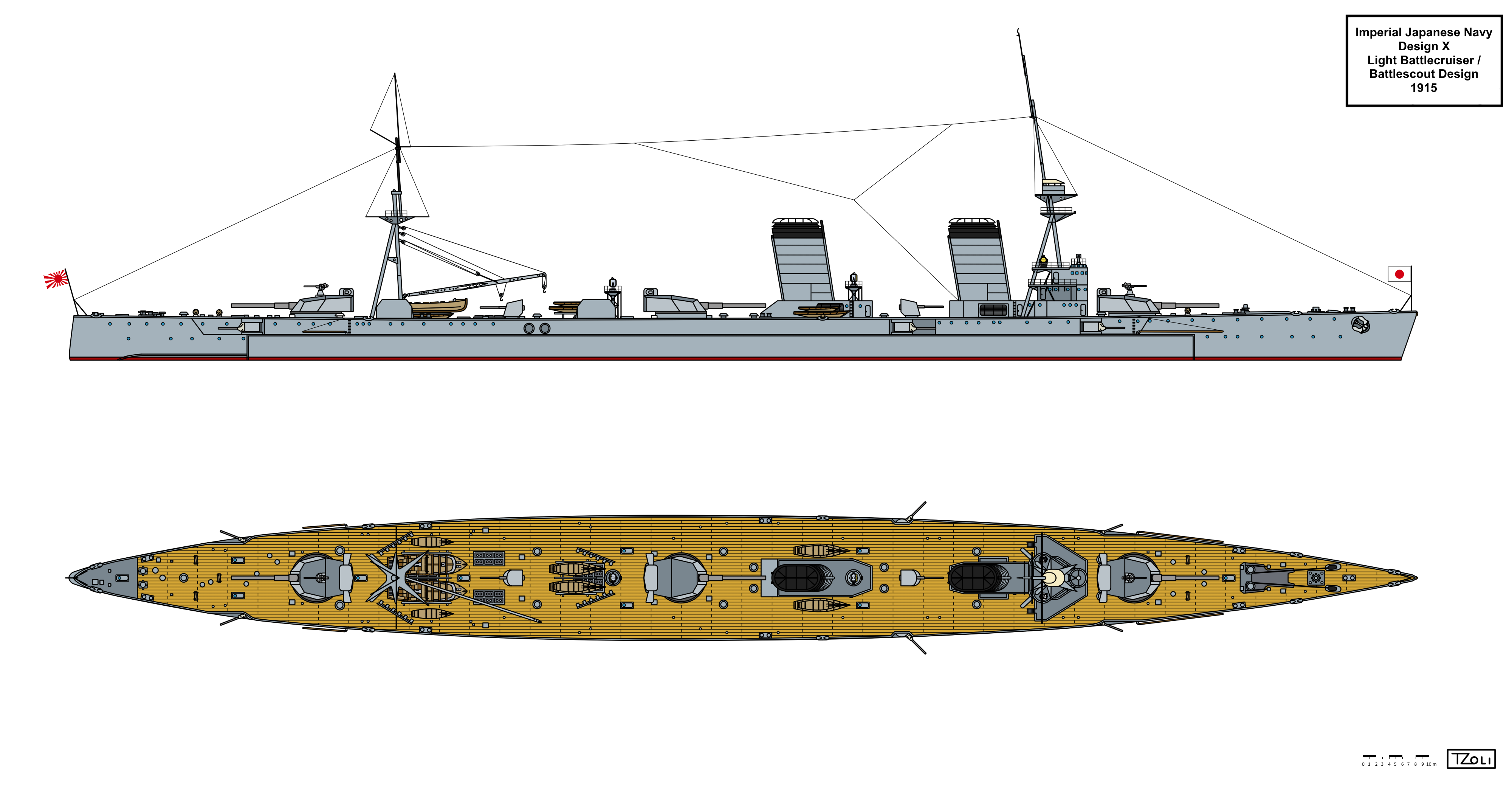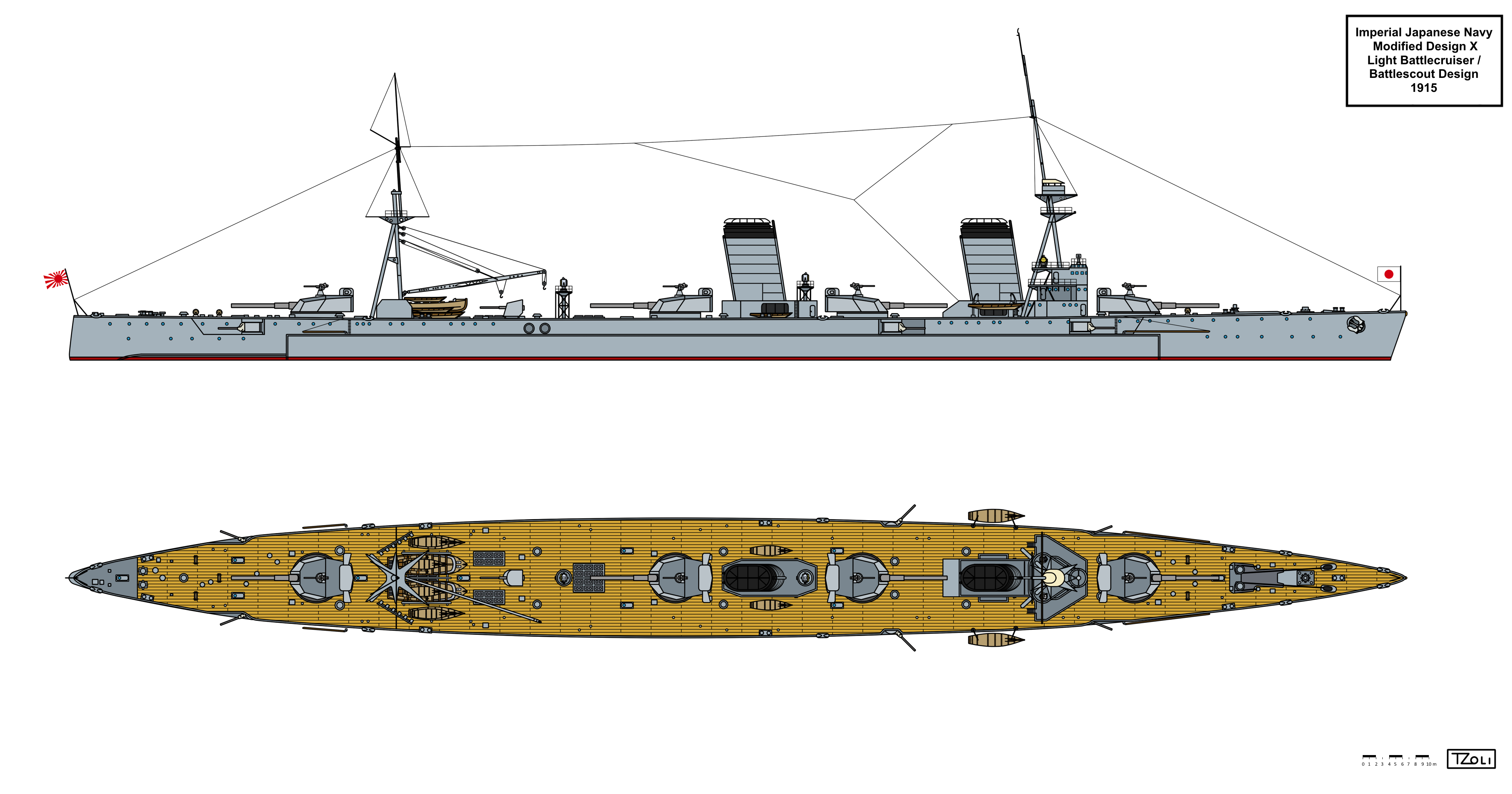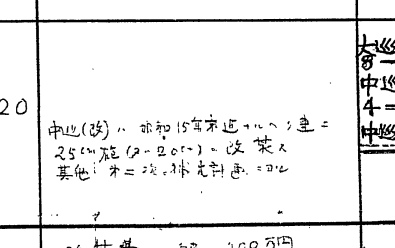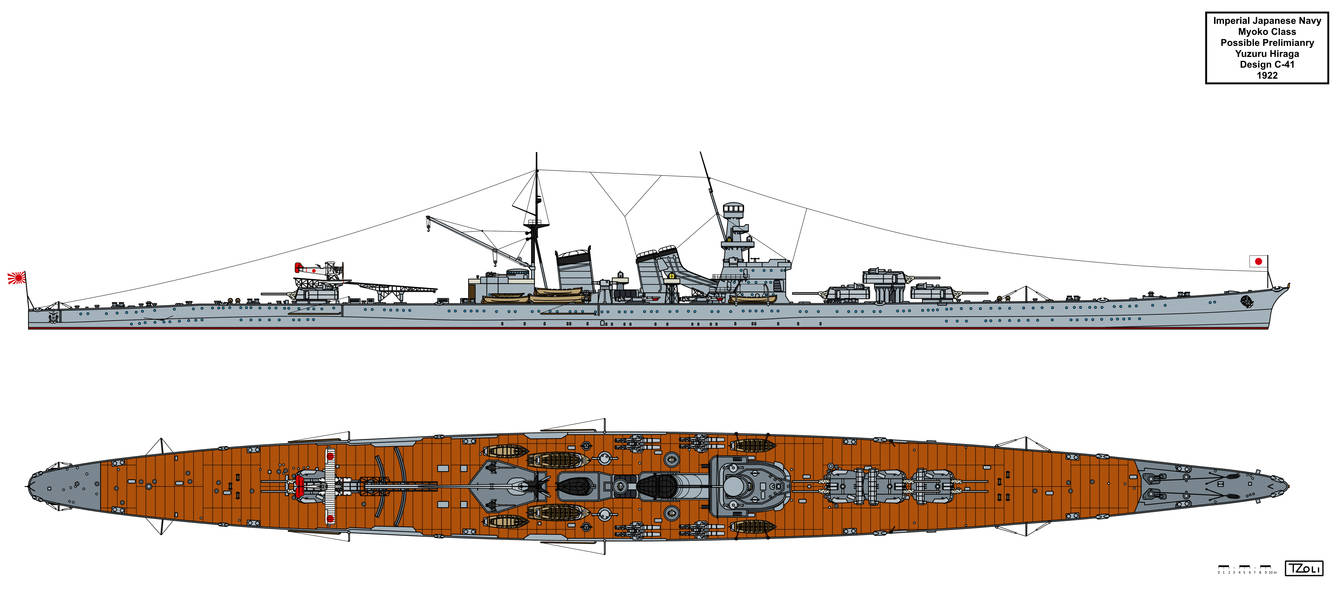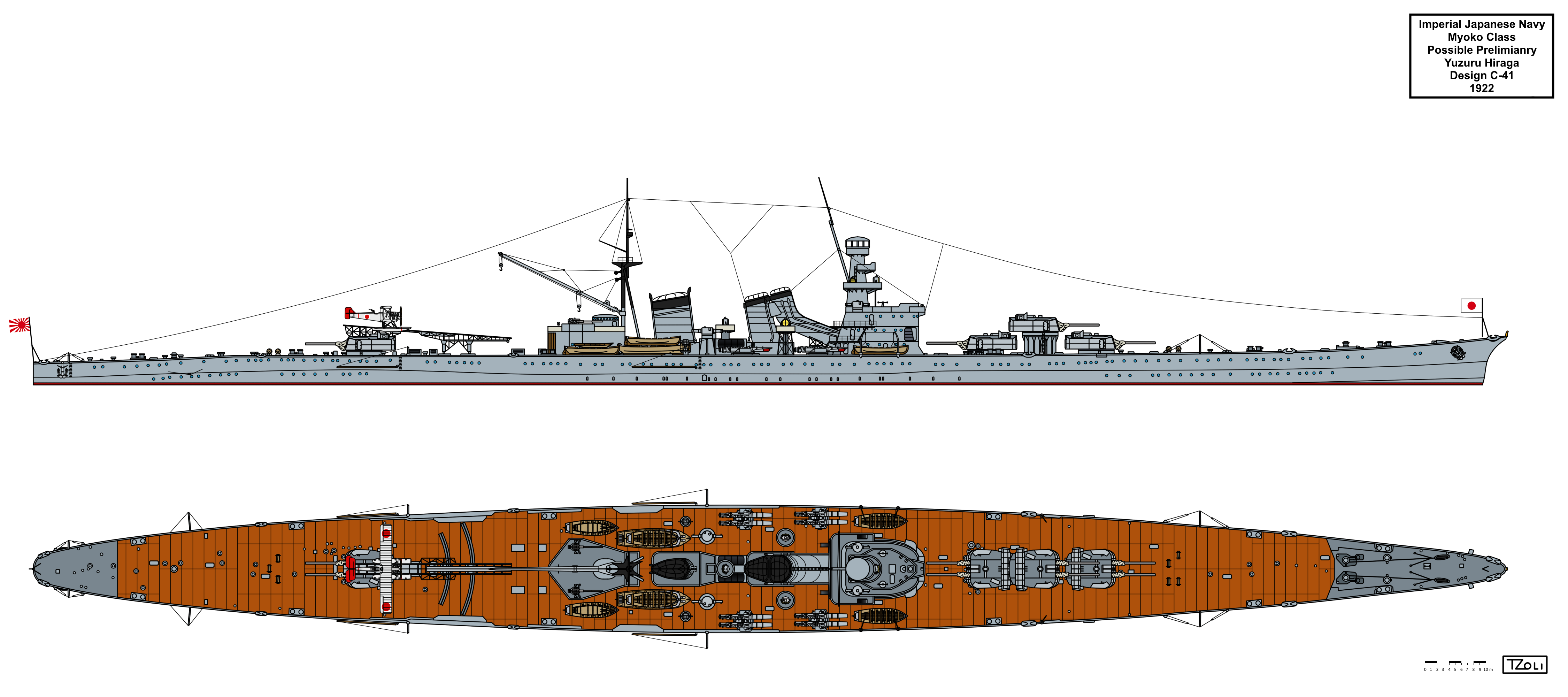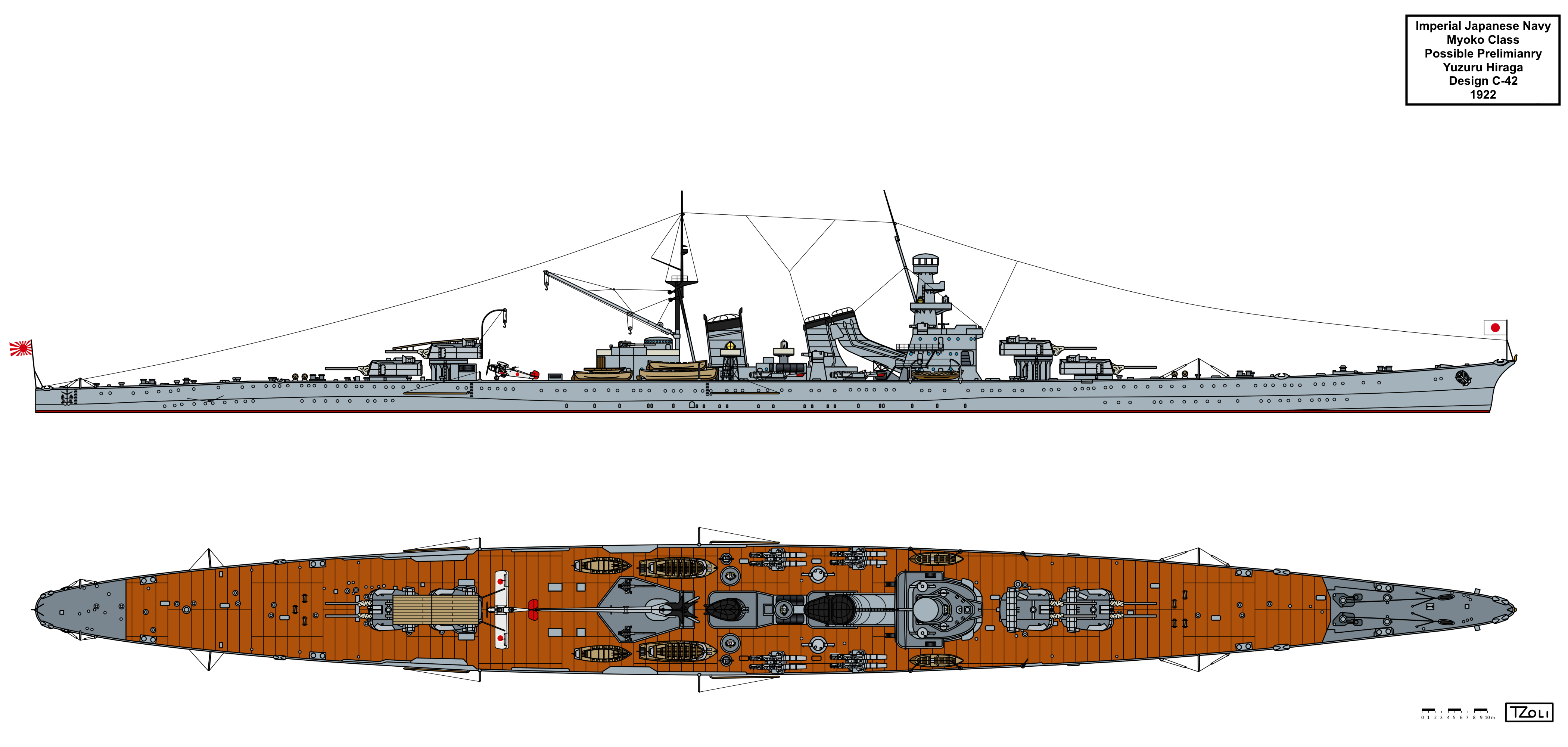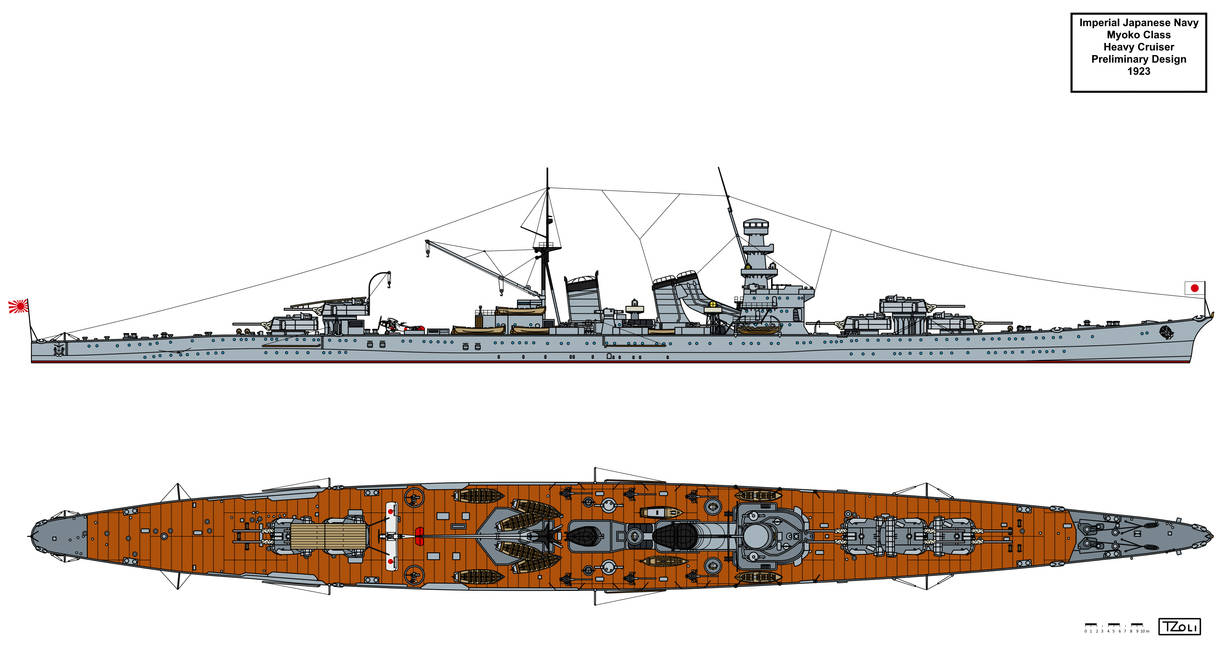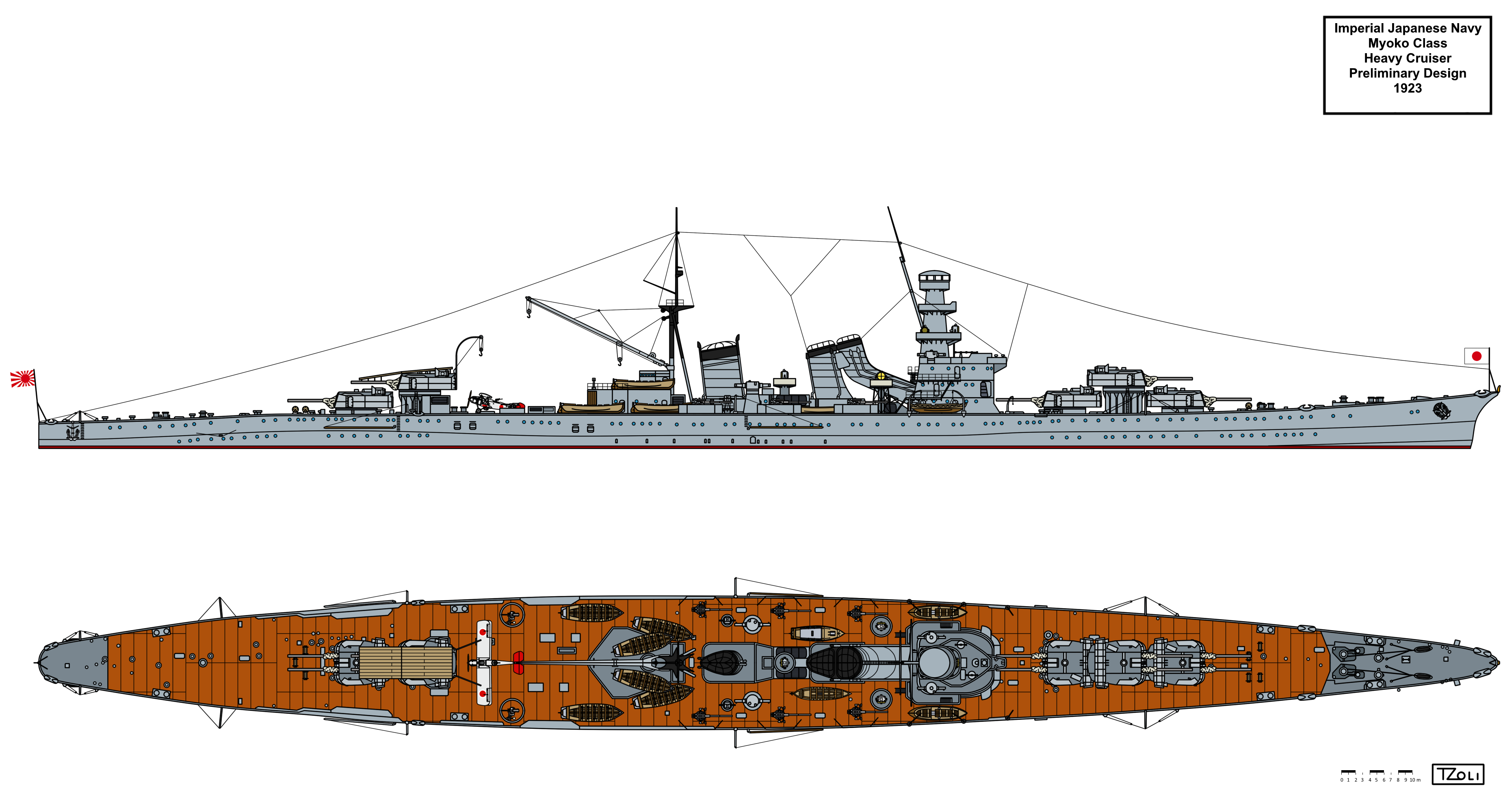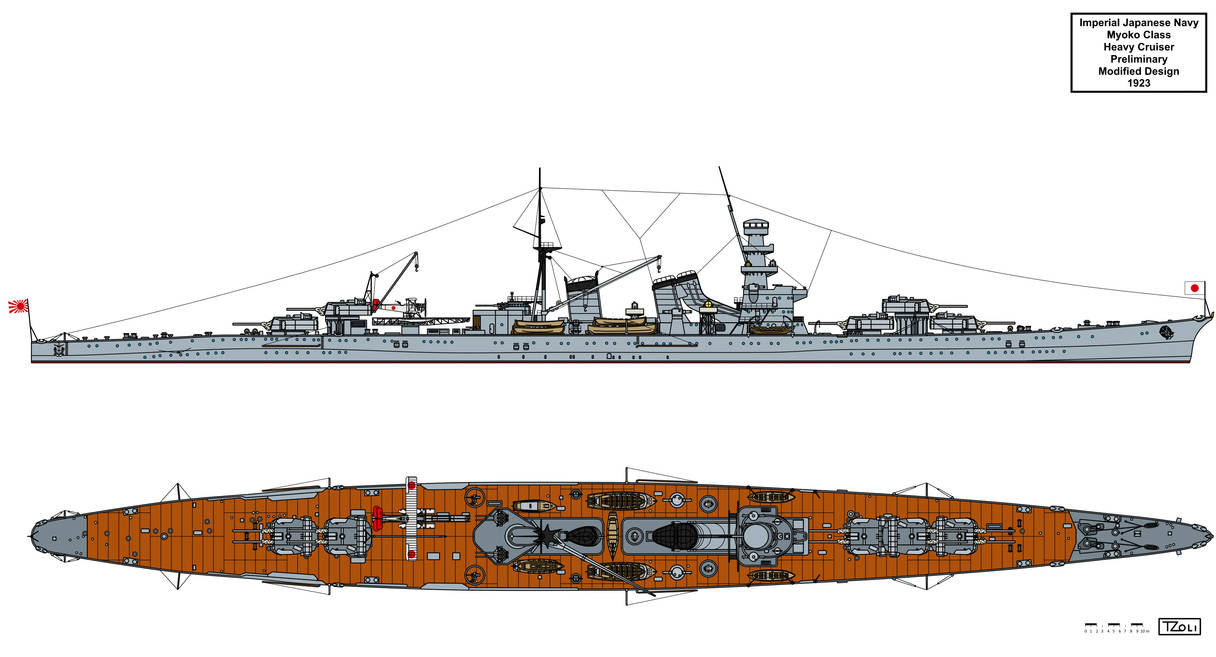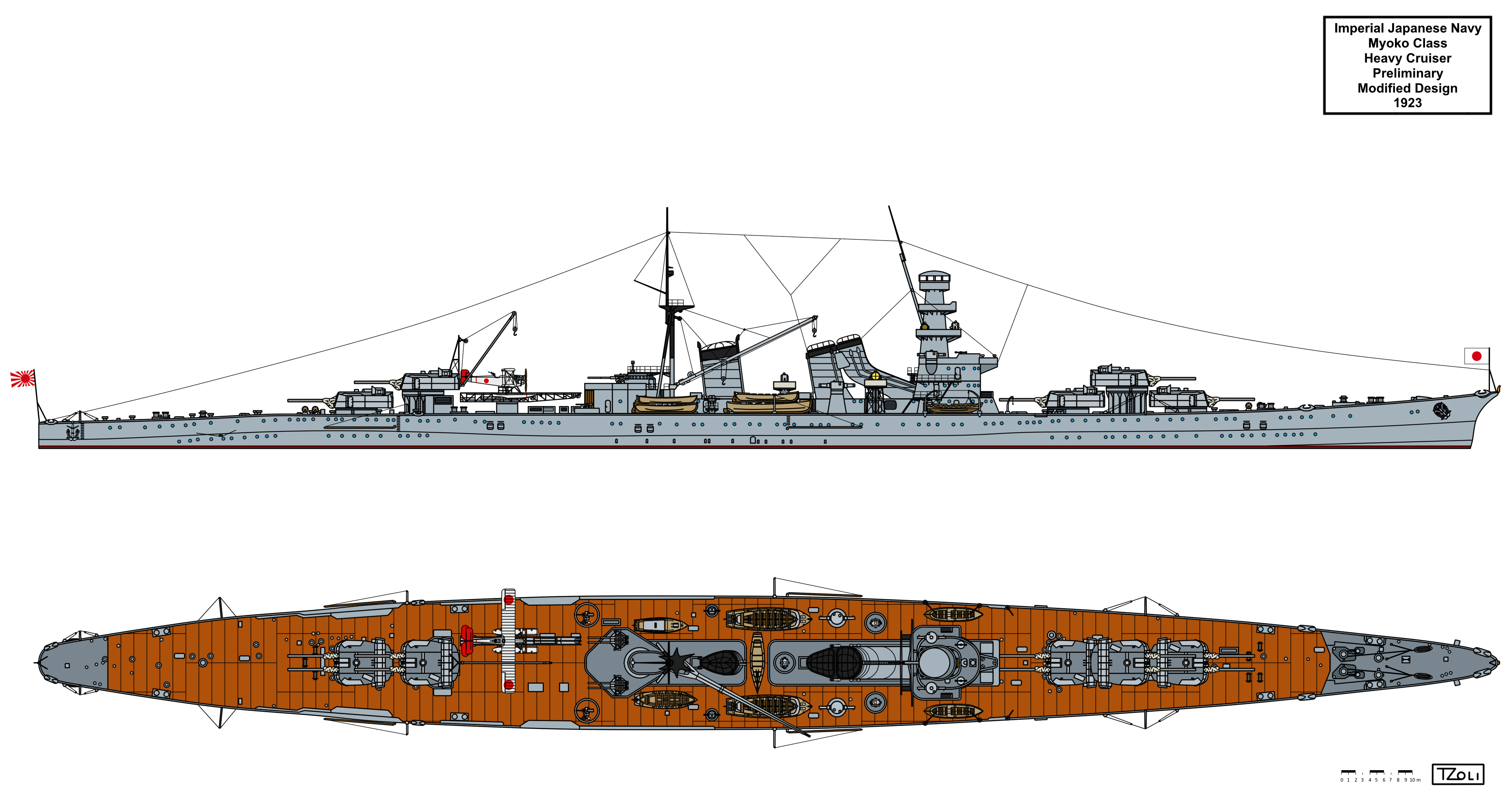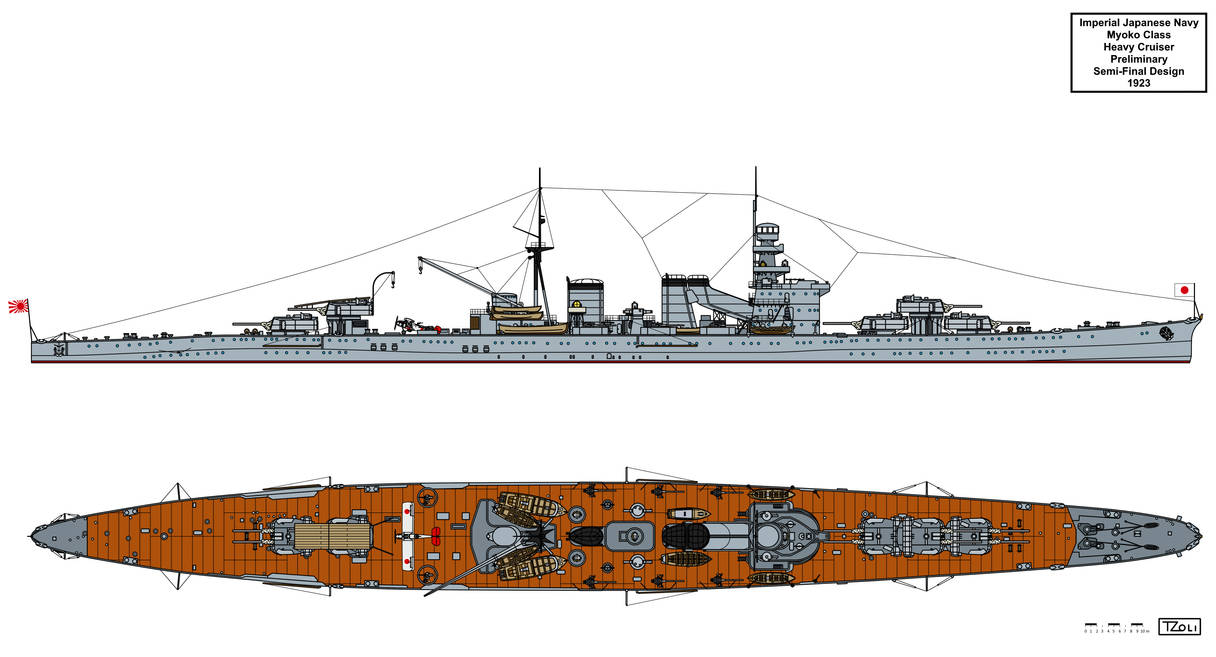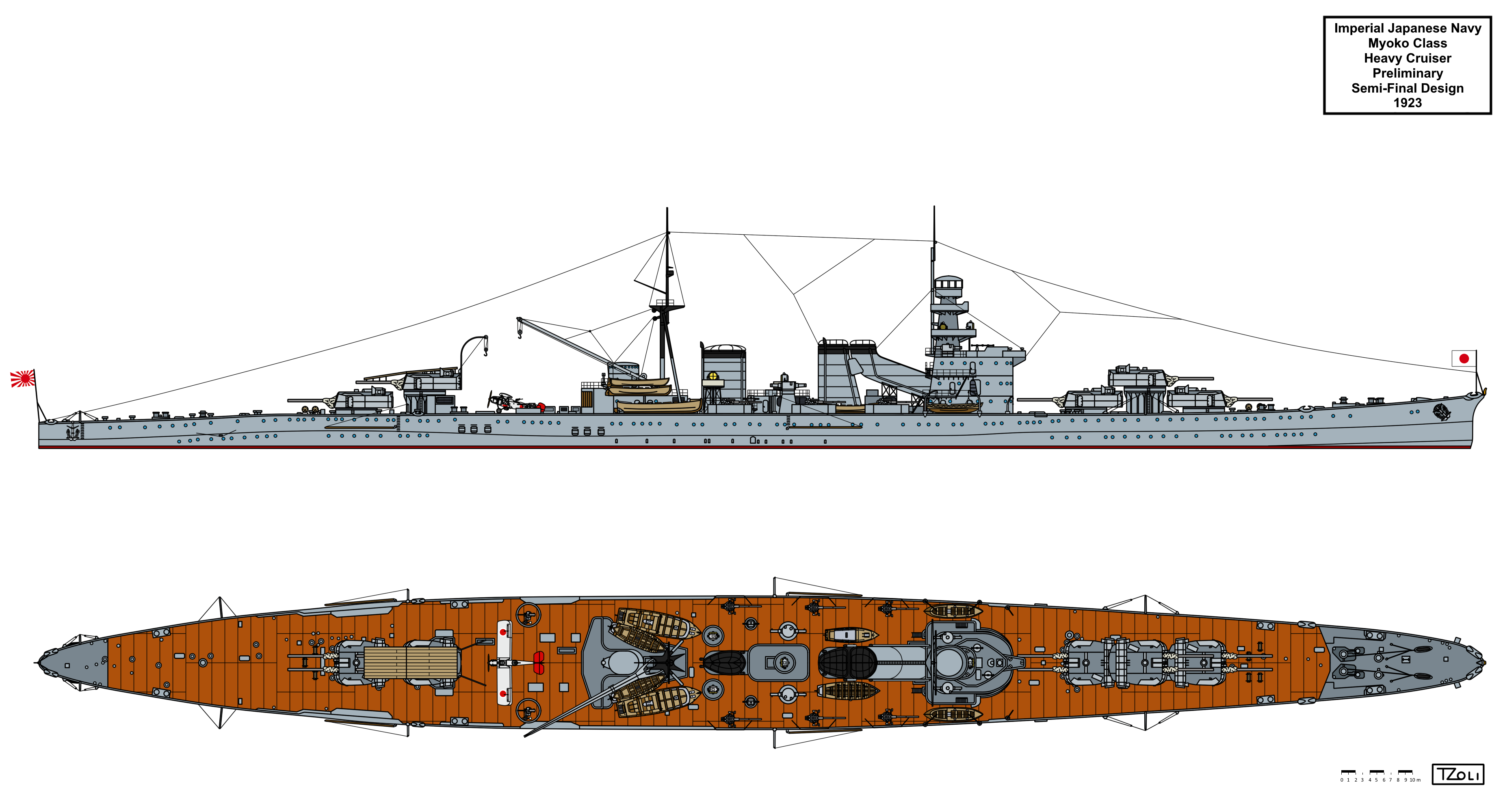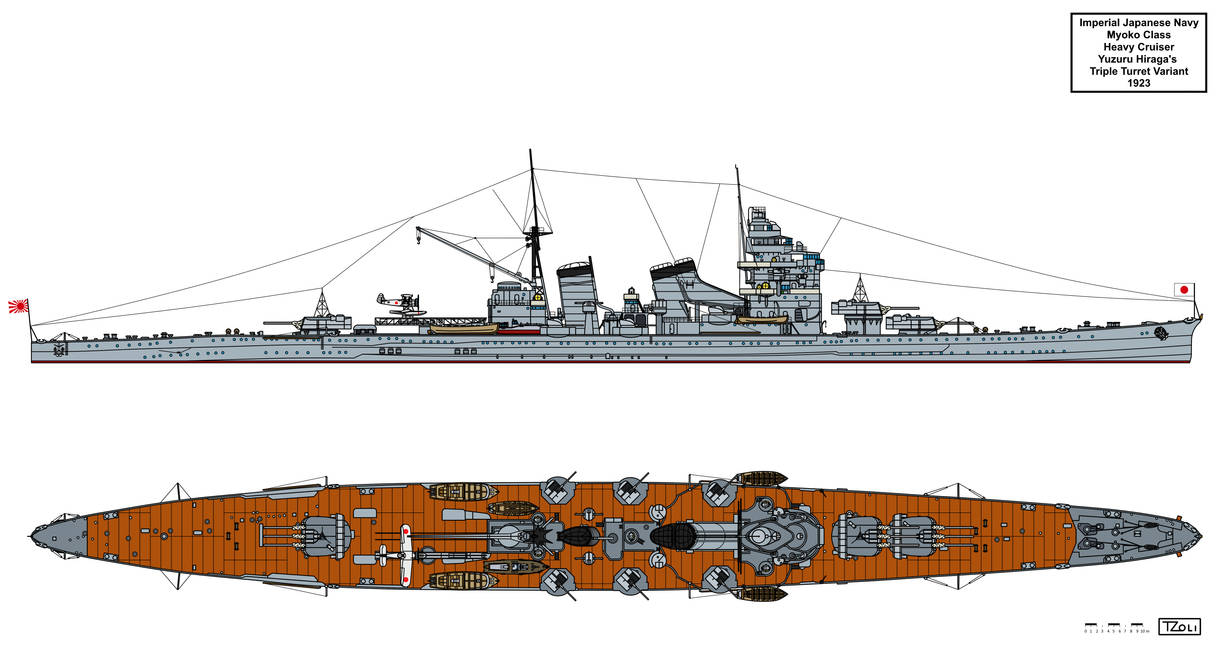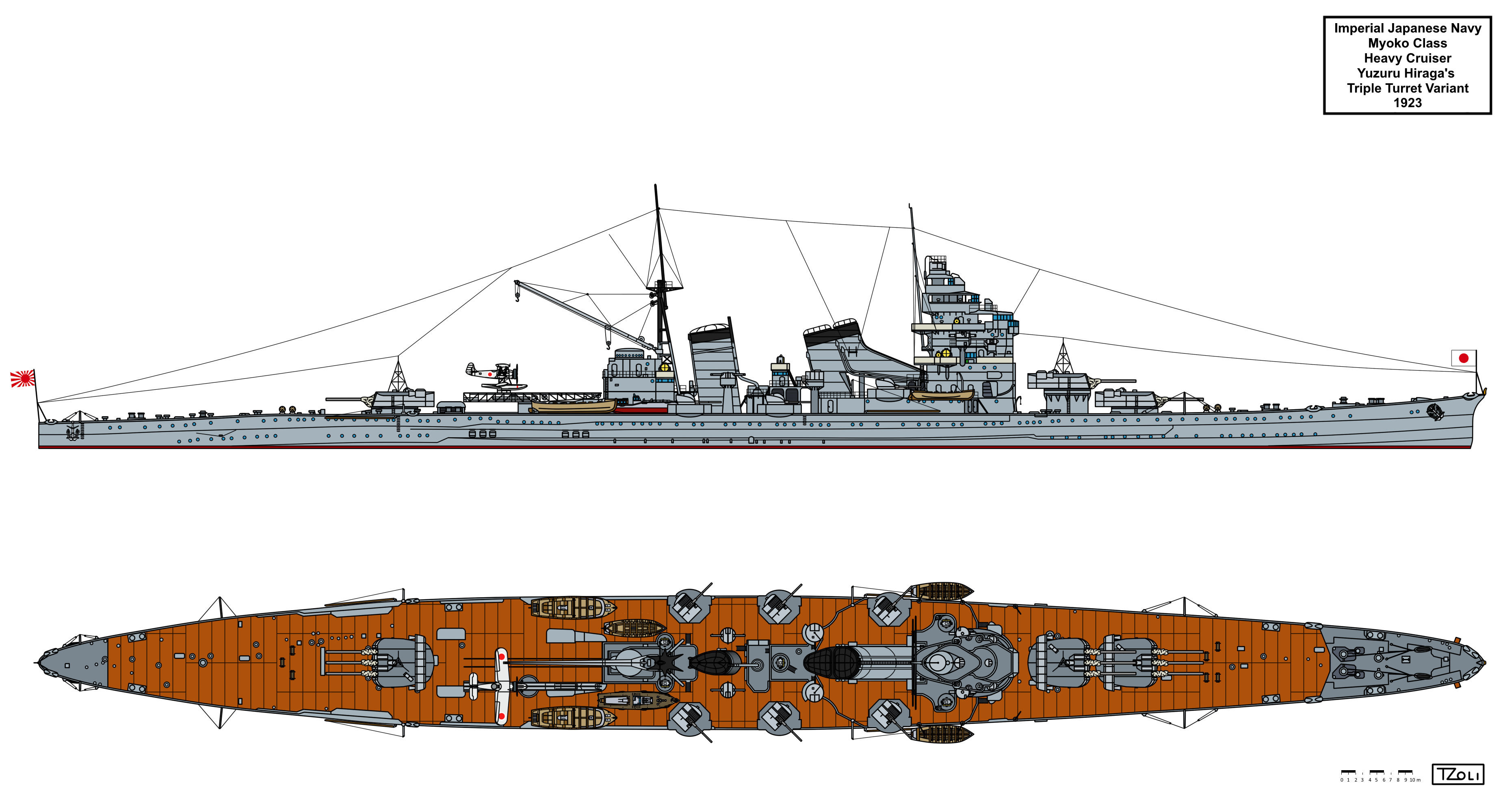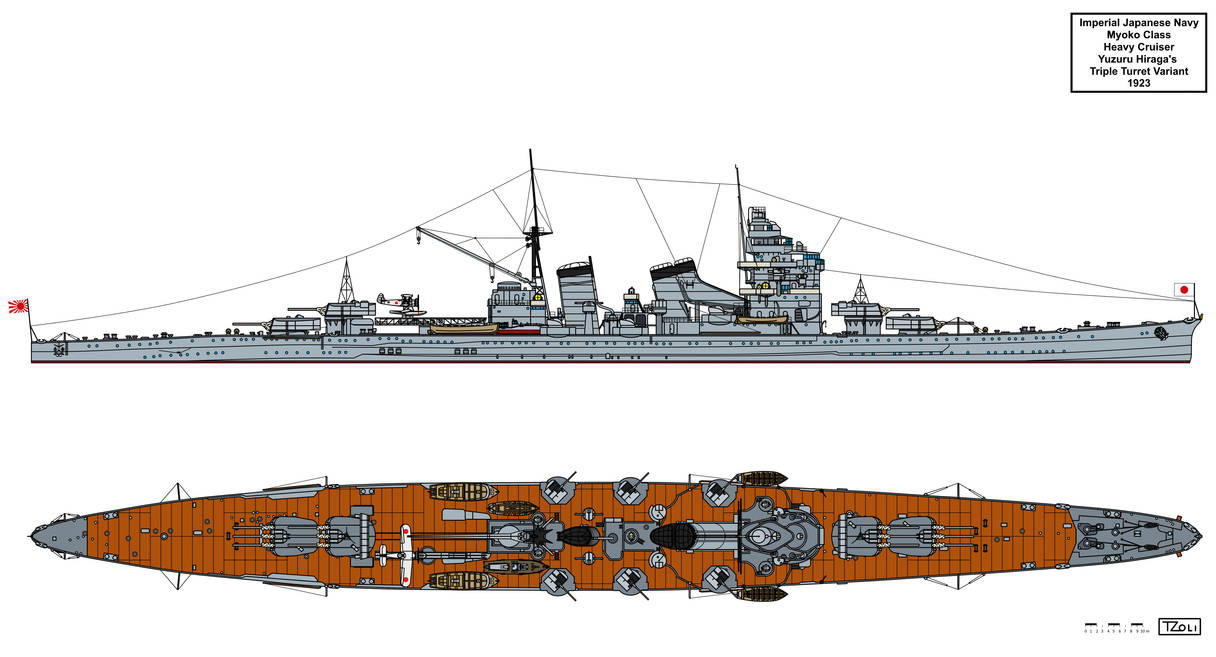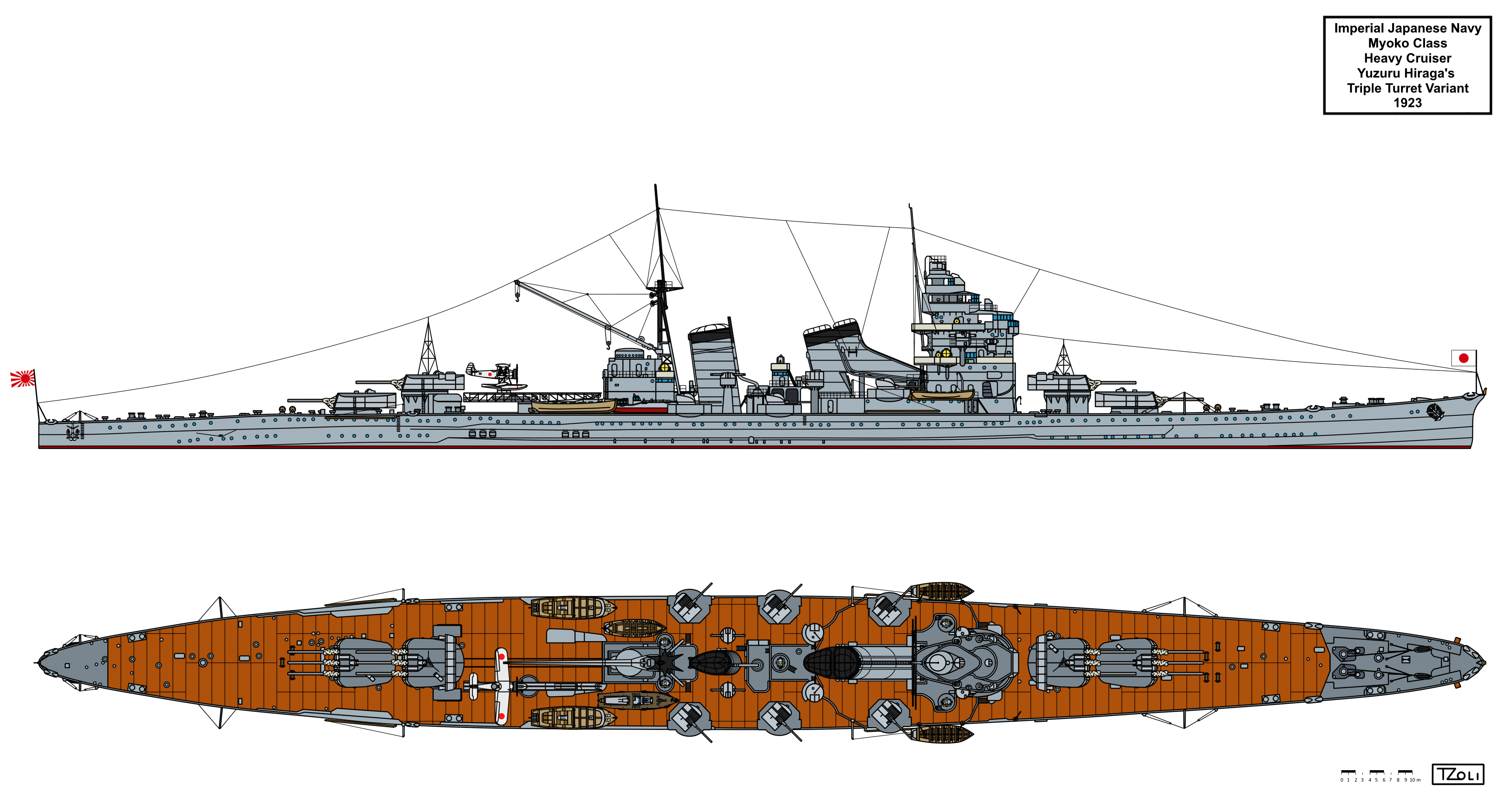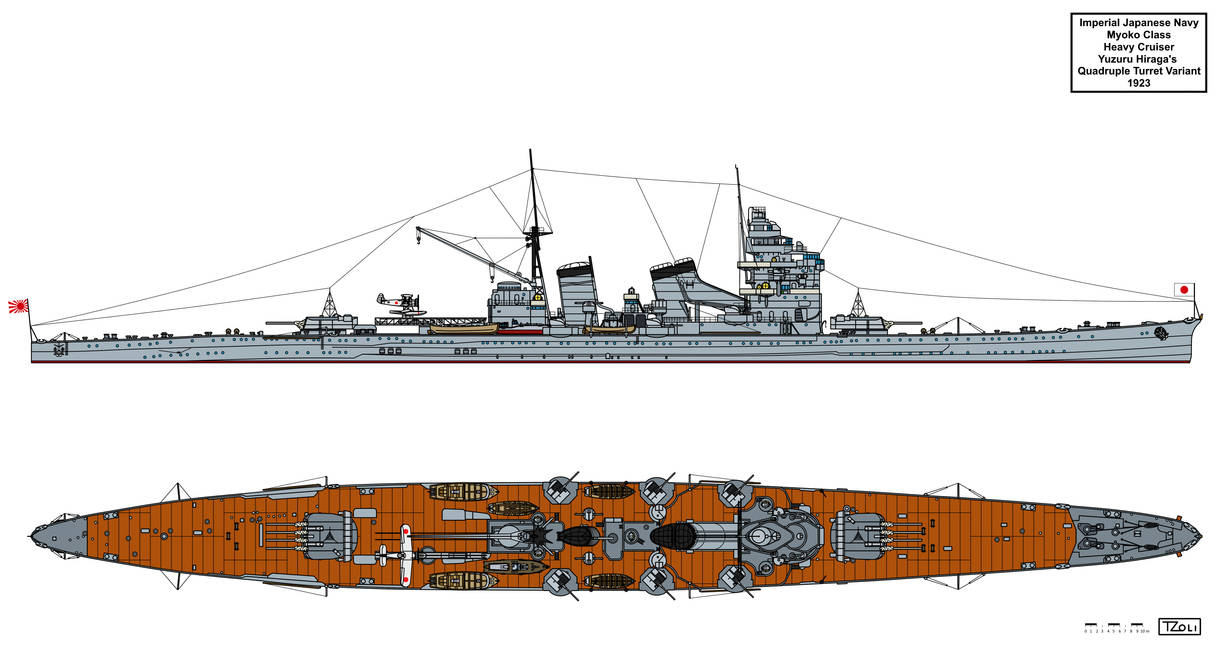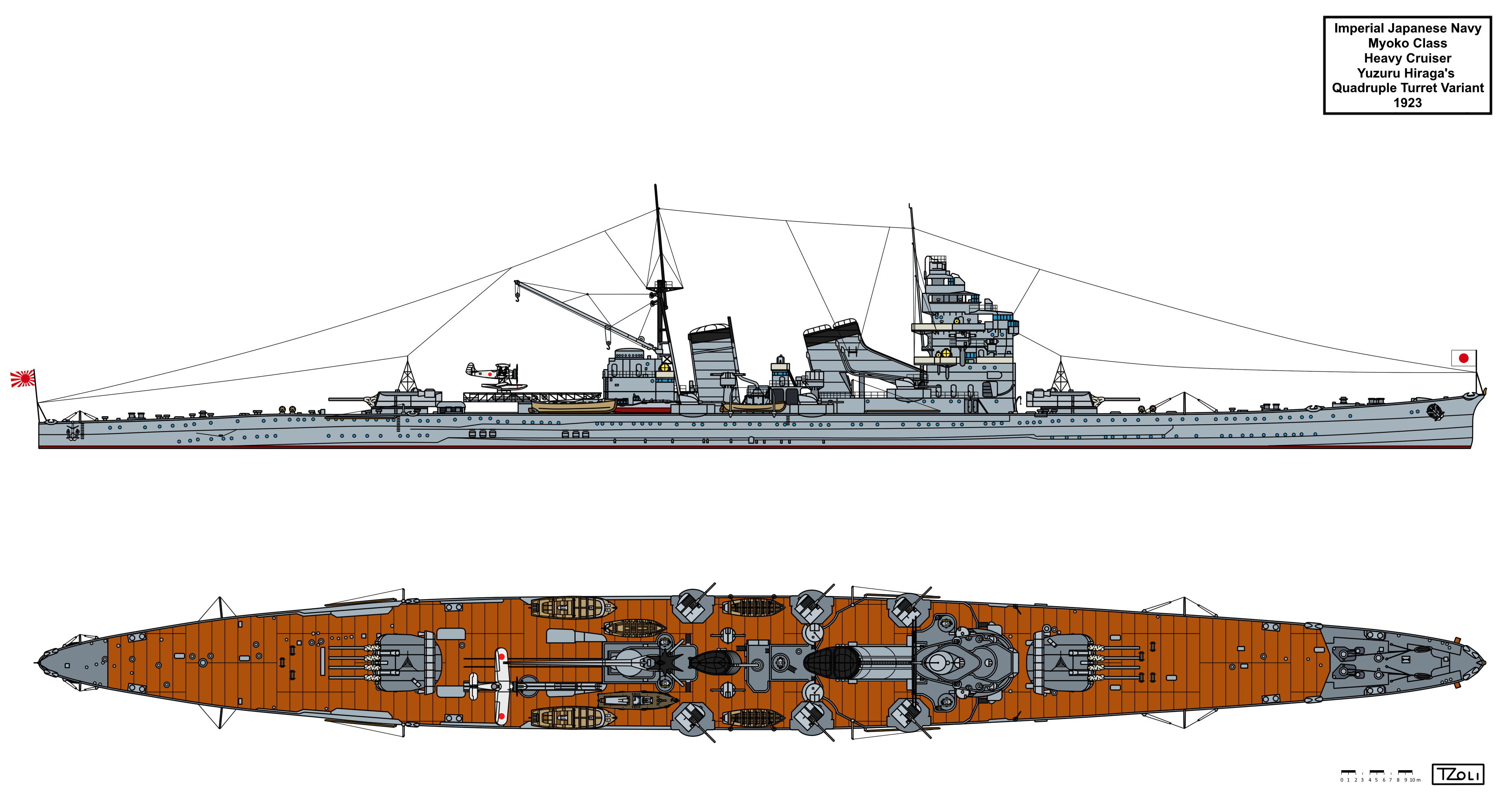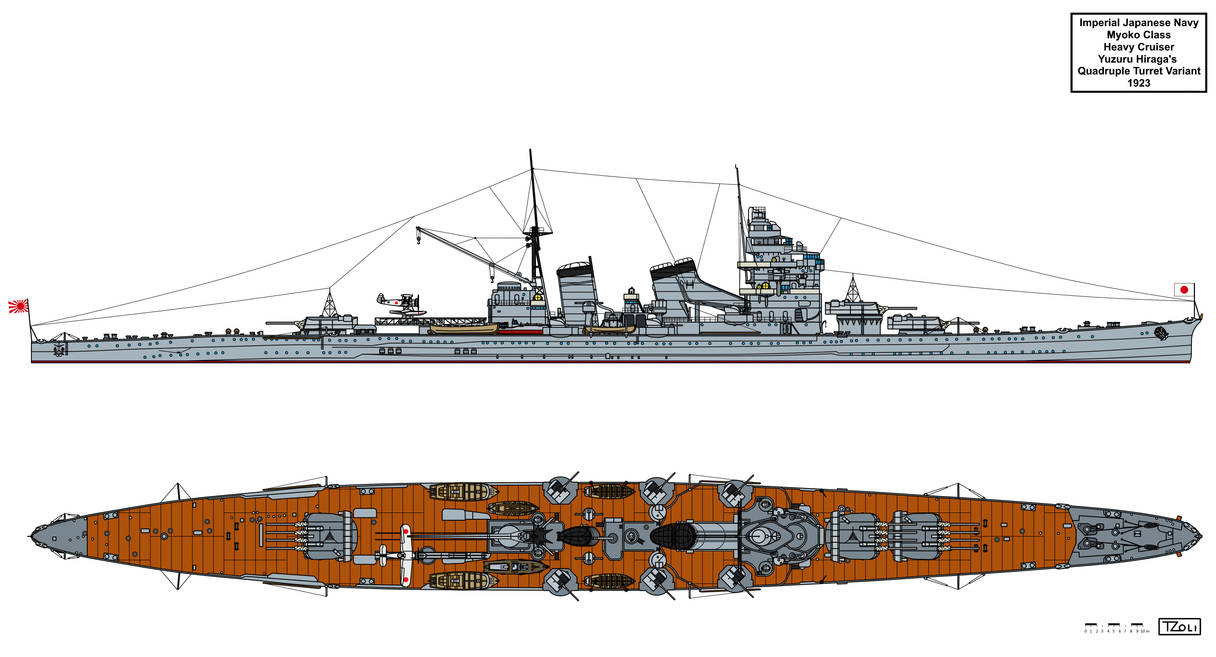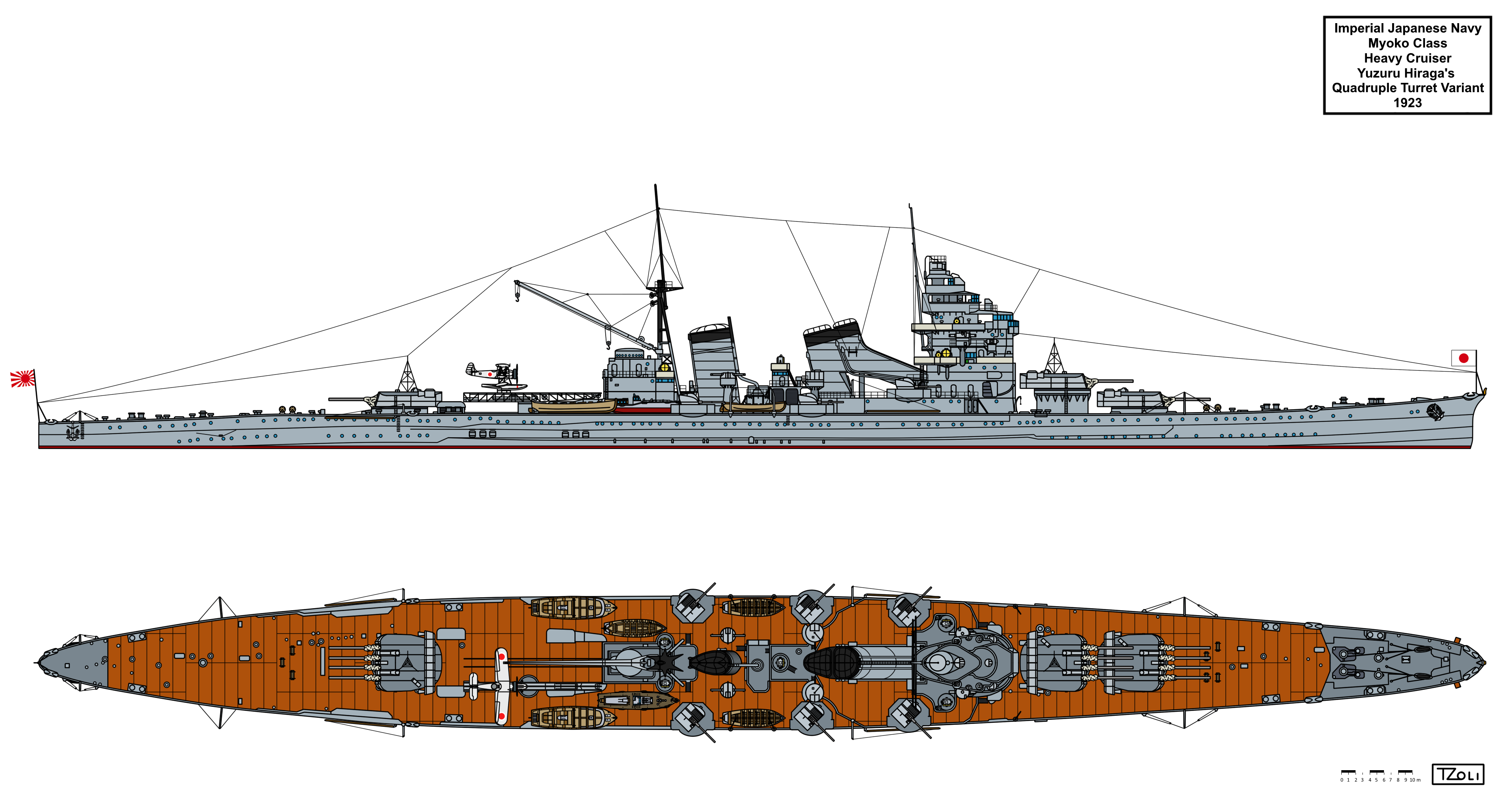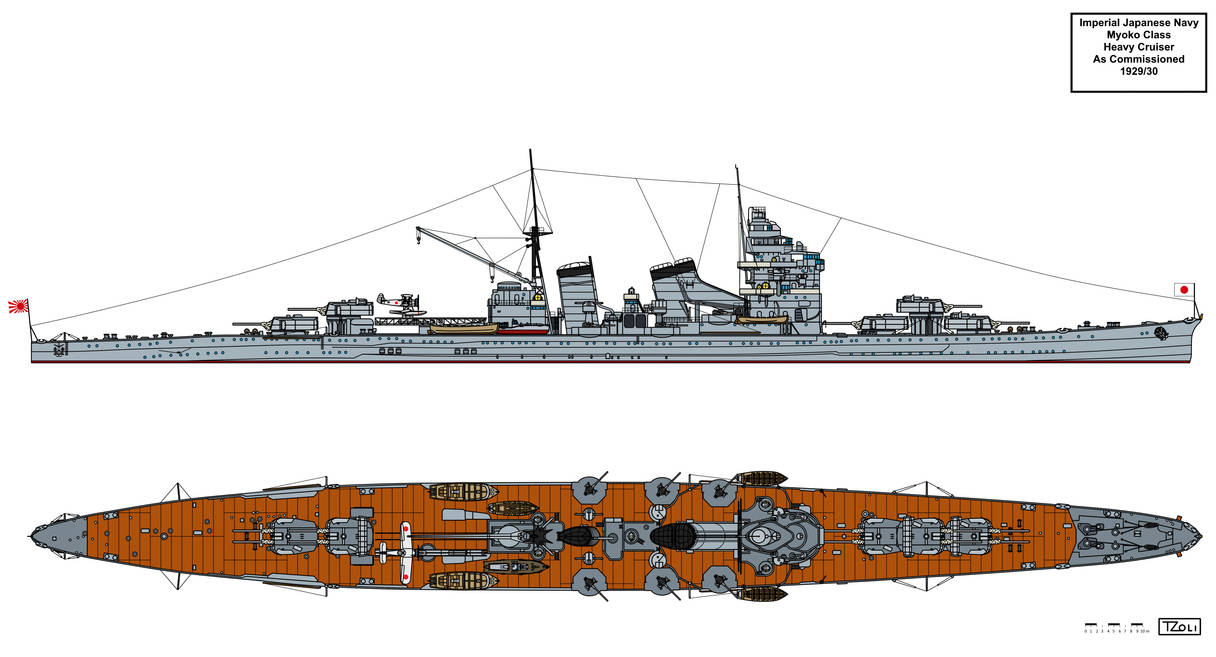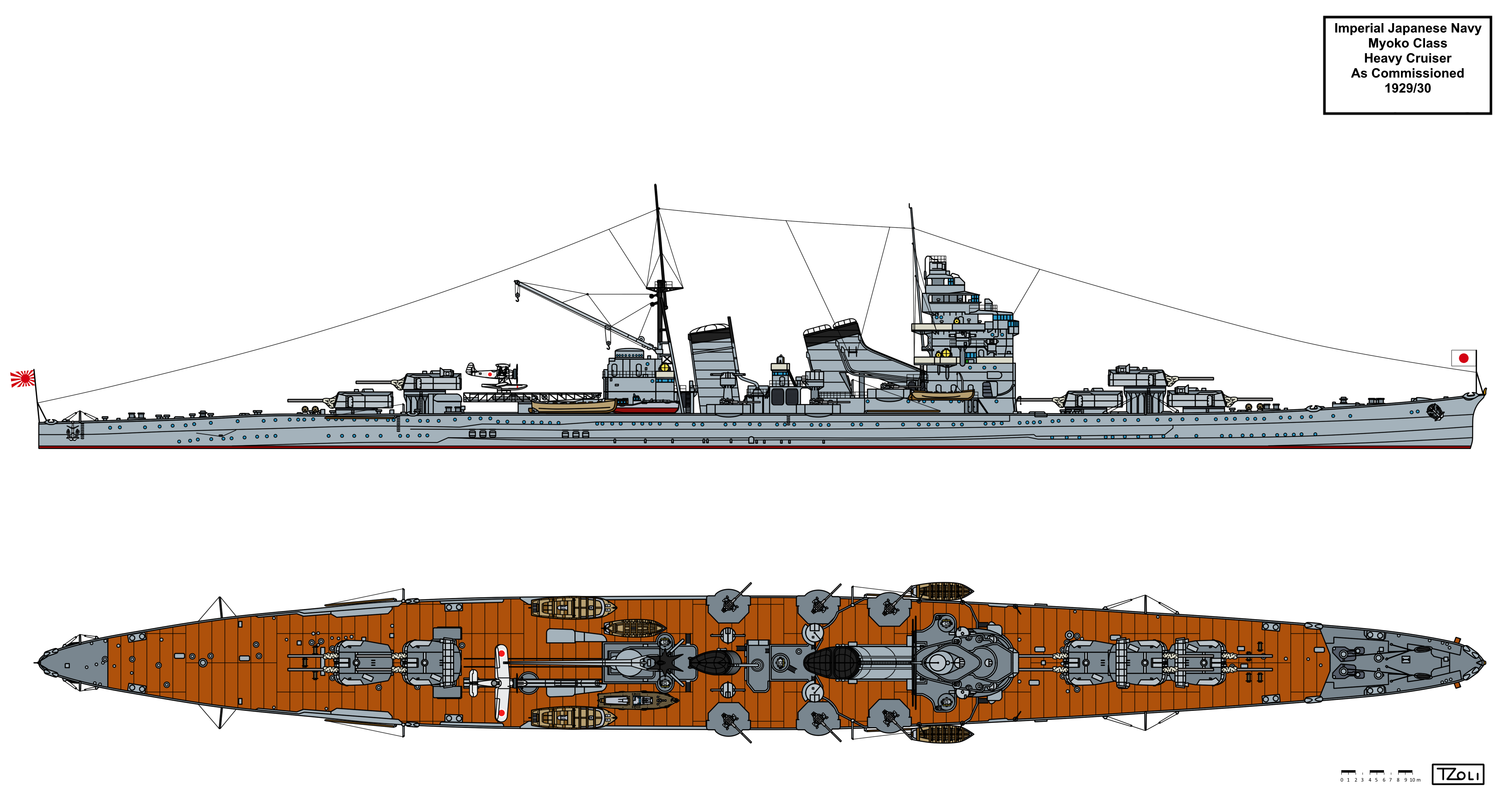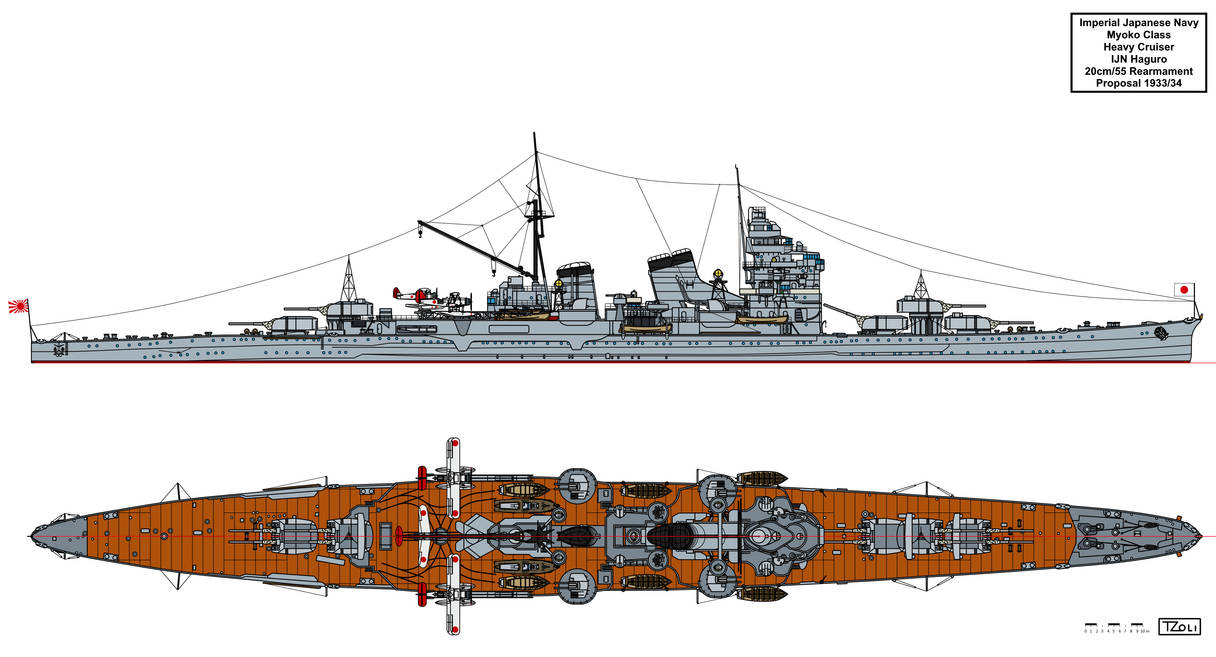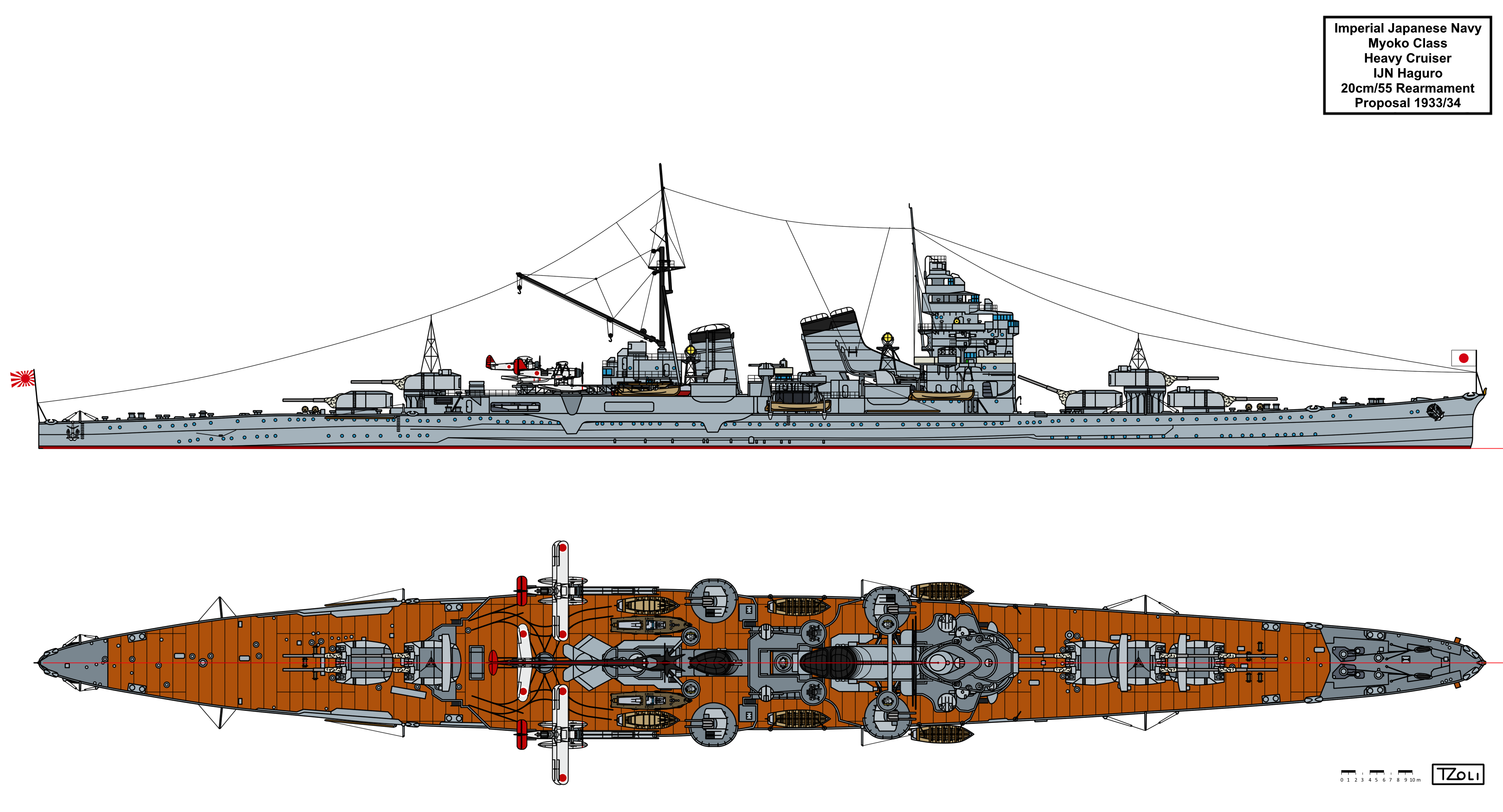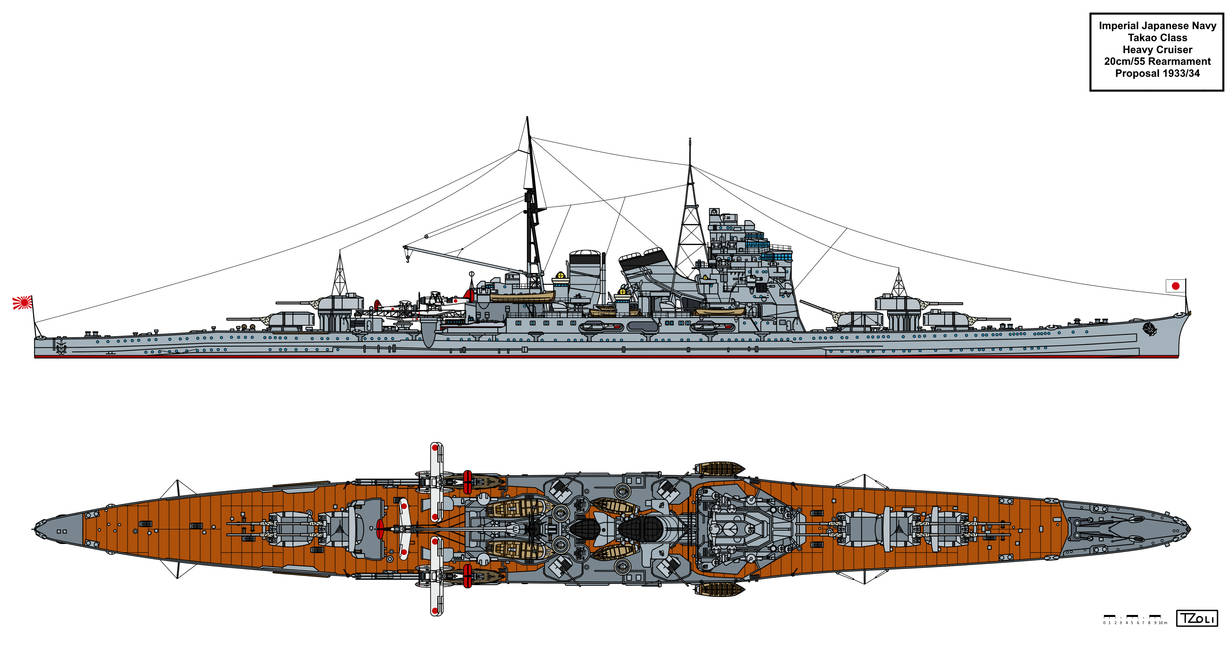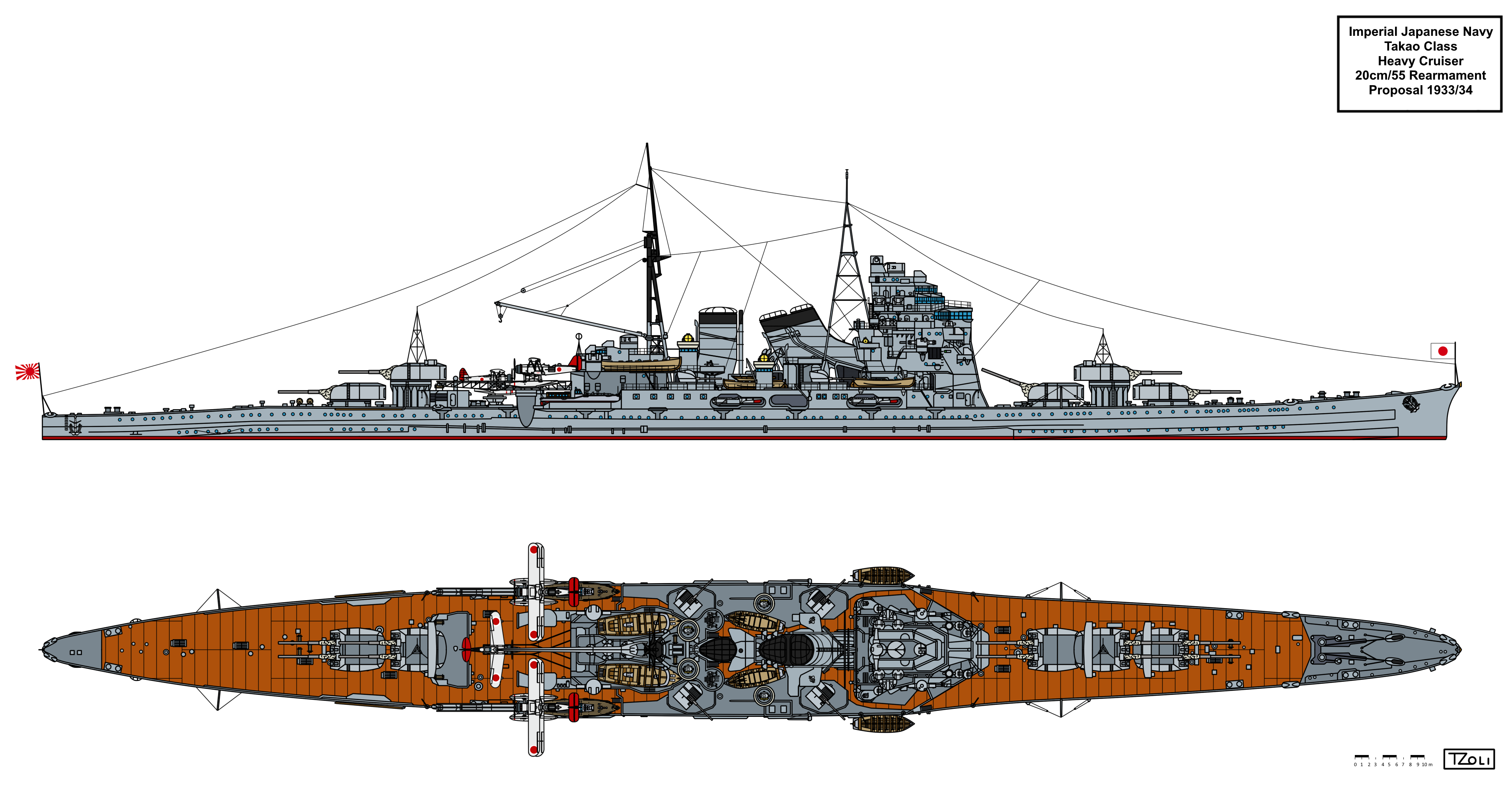- Joined
- 1 February 2011
- Messages
- 2,938
- Reaction score
- 3,623
Here I gathered all the various cruiser designs and projects proposed for the Imperial Japanese Navy
Protected Cruisers:
Not found any so far except the cancelled sister ships of the Unebi and Tone classes
Light Cruisers:
Design C-19 (1912) - A primary mine-layer cruiser design offered before WW1 but not ordered.
Dimensions: 159,41 (pp) x 15,24 x 5,18 meters
Displacement: 6.000tons (standard)
Engines: 28.500shp Steam Turbines, 2 shafts
Range: 18.500km (10.000nm)
Speed: 50km/h (27knots)
Armour: none
Armaments:
4x1 152mm Guns
6x1 76mm Guns
4x1 533mm Torpedo Tubes
100x Mines
Design C-31A (1915) - A WW1 era design for a fast well armed cruiser possibly the baseline design which evolved into the Tenryu and later the Kuma/Nagara/Sendai classes or a development of the proposed 1914 large scout cruiser.
Dimensions: 161,54 (pp) x 15,85 x 5,1 meters
Displacement: 7.000tons (standard)
Engines: 106.000shp Steam Turbines, 4 shafts
Range: 9.200km (5.000nm)
Speed: 65km/h (35knots)
Armour: 25mm Deck, 76mm Belt
Armaments:
9x1 140mm Guns
1x3 533mm Torpedo Tubes
48x Mines
Design C-32 (1915) - A smaller 4.100ton cruiser, very likely part of the Tenryu design process
Dimensions: 140,21 (pp) x 13,41 x 4,11 meters
Displacement: 4.100tons (standard)
Engines: 65.000shp Steam Turbines, 4 shafts
Range: 11.000km (5.900nm)
Speed: 63km/h (34knots)
Armour: 25mm Deck, 63mm Belt
Armaments:
5x1 140mm Guns
2x3 533mm Torpedo Tubes
48x Mines
7.200ton Proposal (1916) - A well armed and armoured scout cruiser proposal first envisioned in 1914 but their slower construction time resulted their postponing to 1916. In 1916 in was re-formed into a 7.200ton cruiser and 3 ships were considered in the 8-4 and 8-6 naval programmes. This designed formed the basis of the later Furutaka class because while originally it was designed with 14cm guns in mind new 20cm guns were considered as well
Source: (Eric Lacroix - Japanese Cruisers of the Pacific War)
View: https://i.imgur.com/amHU9p9.png
Dimensions: unknown
Displacement: 7.200tons (standard)
Engines: unknown
Range: 11.000km (8.000nm)
Speed: 67km/h (36knots)
Armour: 51mm Deck, 76mm Belt
Armaments:
4x2,4x1 140mm Guns
4x2 610mm Torpedo Tubes
Tenryu-Kai type (1917) - 6 modified or improved Tenryu class cruisers were considered to be built from 1917 onward as part of the 8-4 and 8-6 naval programmes. Their designer was Teiji Kawase and only very limited info I could gather was that it's displacement would be 3.500tons compared to 3.230tons of the Tenryu class which indicate more armour somewhat more armament and larger 610mm torpedo tubes with the associated increased engine power.
Source: (Eric Lacroix - Japanese Cruisers of the Pacific War)
View: https://i.imgur.com/bUGIY8e.png
View: https://i.imgur.com/odZJ3E9.png
Furutaka Class original Design (1918) - The design process eventually leading the creation of the Furutaka class Heavy Cruisers was first started with a smaller ship evolved from the previous 7.200ton design to 8.000tons and 5-6 twin 140mm guns in a pyramidal arrangement while the AA armament only consisted of 2 single 76mm guns while the torpedo armament unchanged from the 4 twin 610mm tubes. Armour wise it was much thinner as well with the armoured box protecting only the machinery by 64mm belt and 25mm deck. Eventually based on the data of the USN's Omaha class but especially on the British Hawkins class, this design evolved into the IJN's first heavy cruiser type.
Source: (Eric Lacroix - Japanese Cruisers of the Pacific War)
View: https://i.imgur.com/6rfmXWk.png
View: https://i.imgur.com/s6NRAs5.png
5.600ton Proposal (1919) - A post war fleet escort cruiser design with good armament and very high speed. Possibly a development of the 7.200ton type though not much info is available on it.
Source: (Eric Lacroix - Japanese Cruisers of the Pacific War)
View: https://i.imgur.com/WYXdTJB.png
Dimensions: unknown
Displacement: 5.600tons (standard)
Engines: 102.800shp Steam Turbines, 4 shafts
Range: unknown
Speed: 74km/h (40knots)
Armour: unknown
Armaments:
4x2 140mm Guns
6x2 533 or 610mm Torpedo Tubes
Tenryu-Kai type (1921) - A different source provides more data on the Tenryu-Kai type cruiser putting it to 1921 and with somewhat more displacement.
Dimensions: 143 (oa) x 12,4 x 4 meters
Displacement: 4.080tons (standard)
Engines: 51.000shp Steam Turbines, 3 shafts
Range: 11.000km (8.000nm)
Speed: 61km/h (33knots)
Armour: Over Machinery: 25mm Deck, 63mm Belt
Armaments:
2x2 140mm Guns
1x1 76mm DP-AA Guns
2x2 610mm Torpedo Tubes
Design C-43 (1923) - A squadron leader cruiser proposal found in the Yuzuru Hiraga archive but likely Hiraga's own design number because C-42 was Oyodo and C-44 was the Agano-Kai. Might be connected to the earlier 5.600ton design.
Source: (Hiraga number: 21231001)
 iiif.dl.itc.u-tokyo.ac.jp
Dimensions: 152,4 (pp) x 14,17 x 4,85 meters
iiif.dl.itc.u-tokyo.ac.jp
Dimensions: 152,4 (pp) x 14,17 x 4,85 meters
Displacement: 5.600tons (standard) 7.000tons (Full load)
Engines: 42.750shp Steam Turbines, 3 shafts
Range: 9.200km (5.000nm)
Speed: 65km/h (35knots)
Armour: Over Machinery: 25mm Deck, 64mm Belt
Armaments:
4x2 140mm Guns
2x1 76mm DP-AA Guns
2x2 610mm Torpedo Tubes
100x Mines
5.000ton Proposal (1926) - A well armed true light cruiser on limited displacement and average speed, it's origins are a mystery but might be connected to the numerous Vickers export designs of the time.
Source: (Hiraga number: 21090301)
https://iiif.dl.itc.u-tokyo.ac.jp/repo/s/hiraga/document/13021264-af01-4465-9e41-5611a003d88f#?c=0&m=0&s=0&cv=0&xywh=-659,0,8261,4927
Dimensions: unknown
Displacement: 5.000tons (standard)
Engines: 60.000shp Steam Turbines, 4 shafts
Range: unknown
Speed: 59km/h (30,5knots)
Armour: unknown
Armaments:
3x3 152mm Guns
2x2 120mm DP-AA guns
2x2 533mm Torpedo Tubes
Design 1927 or C-37 (1927) - The earliest interpretation of what became the Mogami class cruisers. Yet to re-find where I've found data of it, but I seems to remember from Eric Lacroix's Japanese Cruiser book
Dimensions: 197meters (wl)
Displacement: 8.500tons (standard) 11.200tons (Full load)
Engines: 152.000shp Steam Turbines, 4 shafts
Range: unknown
Speed: unknown
Armour: 38mm Deck, 125/143mm Belt (Magazines/Machinery)
Armaments:
5x3 155mm Guns
4x1 127mm DP-AA Guns
4x3 610mm Torpedo Tubes
2x Scout Planes
Squadron Leader Design (1928) - Essentially an early interpretation of what became the Agano and Oyodo class cruisers a decade later a cruiser adequately armed and armoured with good speed to lead destroyer and submarine squadrons as well as for doing scouting duties. 6 ships were envisioned but cancelled and replaced by 4 Takao-Kai type cruisers in 1930. Though Eric Lacroix's book states "A main armament of six 50-cal 14-cm guns, in twin mounts with a high elevation" this indicates more to the 55 calibre high angle twin turret envisioned for the Kongo Replacement designs of 1928-29.
Source: (Eric Lacroix - Japanese Cruisers of the Pacific War)
View: https://i.imgur.com/IMUgWsm.png
View: https://i.imgur.com/XzB1SOs.png
Dimensions: unknown
Displacement: 5.000tons (standard)
Engines: 42.750shp Steam Turbines, 3 shafts
Range: 9.200km (5.000nm)
Speed: 65km/h (35knots)
Armour: 51mm Deck, 76mm Belt
Armaments:
3x2 140mm/50 Type 3 or 140mm/55 Type 88 Guns
2x3 610mm Torpedo Tubes
2x Scout Planes
Tone as designed (1934) - Like the Mogami originally the Tone class heavy cruisers too were designed with 155mm guns in mind, in triple turrets all forward and likely similar modified Takao or further modified Takao style brdige, but the Tomozoru incident as well as the worsening political situation meant these ships got modified Mogami bridges and the standard 20cm guns as the other IJN heavy cruisers of the time
Source: (Eric Lacroix - Japanese Cruisers of the Pacific Wa
View: https://i.imgur.com/0N586GD.png
View: https://i.imgur.com/iGFqSMz.png
Squadron Leader Design (1937) - The immediate precursor of the Agano class cruisers but on a smaller displacement and with Oyodo style armament and better heavy AA. 5 such ships were considered to be built in the Maru 3 programme but voted down by the Diet.
Source: (Eric Lacroix - Japanese Cruisers of the Pacific War)
Dimensions: unknown
Displacement: 5.000tons (standard)
Engines: unknown
Range: 13.000km (7.000nm)
Speed: 67km/h (36knots)
Armour: 100mm Belt
Armaments:
2x3 155mm/60 Type 90 Guns
4x2 76mm/60 Type 98 DP-AA Guns
3x2 25mm/60 Type 96 AA guns
2x4 610mm Torpedo Tubes
1x Seaplane
Kuma Class Original Torpedo Cruiser Conversion proposal (1938) - As to be compatible with the new night fighting doctrine the IJN experimenting with, 3 of the 5 Kuma class cruisers were to be converted into a Torpedo Cruiser with very heavy torpedo armament to destroy or scatter entire enemy fleets. The conversion was actually done but to a modified design and for only 2 ships. The original proposal had these armaments for the cruisers:
4x2 127mm/40 Type 89 DP-AA guns, 4x2 25mm/60 Type 96 AA guns and 11x quadruple 610mm Torpedo Launchers: 5 per side and 1 one the centreline! The production bottleneck for the torpedos and their launchers as well as the 127mm DP-AA guns meant that the revised design only applied to two ships with most of their original armament remained impact with reduced torpedo launcher number.
Design C-39 (1938) - The first known preliminary design leading to the Agano class light cruisers with different engine power, longer range and slightly smaller displacement, different torpedo arrangement and with two funnels.
Source: (Eric Lacroix - Japanese Cruisers of the Pacific War)
Dimensions: 162 (pp) x 173 (wl) x 174,5 (oa) x 15,2 x 5,6 meters
Displacement: 6.585tons (standard) 7.800tons (Full load)
Engines: 112.000shp Steam Turbines, 4 shafts
Range: 14.800km (8.000nm)
Speed: 67km/h (36knots)
Armour: 20mm Deck, 55/60mm Belt (Magazines/Machinery)
Armaments:
3x2 152mm Type 43 Guns
2x2 76mm/60 Type 98 DP-AA Guns
2x3 25mm/60 Type 96 AA guns
2x4 610mm Torpedo Tubes
18x Depth Charges
2x Seaplanes
Design C-39 Modified (1938) - After the baseline C-39 design was made some modifications were made on the design mostly to the hull length and reduced engine power:
Source: (Eric Lacroix - Japanese Cruisers of the Pacific War)
Dimensions: 170 (wl) x 15,2 x 5,6 meters
Displacement: 6.450tons (standard) 7.600tons (Full load)
Engines: 99.000shp Steam Turbines, 4 shafts
Range: 14.800km (8.000nm)
Speed: 65km/h (35knots)
Armour: 20mm Deck, 55/60mm Belt (Magazines/Machinery)
Armaments:
3x2 152mm Type 43 Guns
2x2 76mm/60 Type 98 DP-AA Guns
2x3 25mm/60 Type 96 AA guns
2x4 610mm Torpedo Tubes
18x Depth Charges
2x Seaplanes
Oyodo Preliminary Design 1 (1938) - One of the design studies considered for the Submarine squadron leader type cruisers of the Oyodo class. Heavy DP-AA guns 2 forward and two on the sides, aircraft capacity for 6-8 planes and two catapults
Source: (Eric Lacroix - Japanese Cruisers of the Pacific War)
Dimensions: unknown
Displacement: 5.000tons (standard)
Engines: unknown
Range: 18.500km (10.000nm)
Speed: 67km/h (36knots)
Armour: unknown
Armaments:
4x2 127mm/40 Type 89 DP-AA Guns
6x3 25mm/60 Type 96 AA guns
6-8x Seaplanes, likely E16A Paul types
Oyodo Preliminary Design 2 (1938) - A refined version of the previous design where the catapults located at almost side by side.
Source: (Eric Lacroix - Japanese Cruisers of the Pacific War)
Dimensions: unknown
Displacement: 6.600tons (standard)
Engines: unknown
Range: 18.500km (10.000nm)
Speed: 67km/h (36knots)
Armour: unknown
Armaments:
4x2 127mm/40 Type 89 DP-AA Guns
6x3 25mm/60 Type 96 AA guns
6x Seaplanes, likely E16A Paul types
Oyodo Preliminary Design 3 (1938) - The basic design which developed further into the Oyodo class almost the same as the original just different aircraft handling facilities and shorter range but with the long 45m catapult aft.
Source: (Eric Lacroix - Japanese Cruisers of the Pacific War)
Dimensions: unknown
Displacement: 8.200tons (standard) 9.800tons (Full load)
Engines: 110.000shp Steam Turbines, 4 shafts
Range: 18.500km (10.000nm)
Speed: 65km/h (35knots)
Armour: unknown
Armaments:
2x3 155mm/60 Type 90 Guns
4x2 100mm/60 Type 98 DP-AA Guns
8x2 25mm/60 Type 96 AA guns
6x Seaplanes, likely E16A Paul types
Design C-44 Agano Kai (1941) - An improved or modified Agano with 4 main turrets and higher speed. 7 units ordered in 1941 to replace the aging 5.500ton type (Kuma, Nagara, Sendai) cruisers
Source: (Eric Lacroix - Japanese Cruisers of the Pacific War)
Dimensions: 175 (pp) x 184 (wl) x 16,4 x 5,9 meters
Displacement: 8.250tons (standard) 9.670tons (Full load)
Engines: 153.000shp Steam Turbines, 4 shafts
Range: 11.600km (6.300nm)
Speed: 70km/h (38knots)
Armour: 20mm Deck, 55/60mm Belt (Magazines/Machinery)
Armaments:
4x2 152mm Type 43 Guns
4x2 76mm/60 Type 98 DP-AA Guns
3x3 25mm/60 Type 96 AA guns
2x4 610mm Torpedo Tubes
2x Seaplanes
Armoured Cruisers:
Only found one so far, the First Class Armoured Cruiser Design from 1904/05. A modern looking 6" armed cruiser with most of its guns in twin circular turrets and often seen accompanied with the First class battleship drawing from the same year. The origins are not entirely clear but likely the result of the Battle of Tsushima. Drawings were found in the Hiraga archive as well as in Japanese books and magazines.
Source: (Battleships and Battle Cruisers of the IJN by Ishibashi Takao)
Source: (Hiraga number: 20200201)
 iiif.dl.itc.u-tokyo.ac.jp
Dimensions: 144,78 (oa) x 21,34 x 7,92 meters
iiif.dl.itc.u-tokyo.ac.jp
Dimensions: 144,78 (oa) x 21,34 x 7,92 meters
Displacement: 12.000tons (standard)
Engines: unknown
Range: unknown
Speed: 41km/h (22knots)
Armour: 51mm Deck, 51mm Slopes, 152mm Belt
Armaments:
8x2,4x1 152mm Guns
6x1 120 Guns
4x1 457mm Torpedo Tubes
Heavy Cruisers:
Design C-41 (1923) - A heavy cruiser proposal found in the Yuzuru Hiraga archive but likely Hiraga's own design number because C-41 was actually the Agano class. Might be connected to the Myoko class design process. Very heavy displacement compared to armour and armament.
Source: (Hiraga number: 21231001)
 iiif.dl.itc.u-tokyo.ac.jp
Dimensions: 225,5 (pp) x 21,64 x 5,33 meters
iiif.dl.itc.u-tokyo.ac.jp
Dimensions: 225,5 (pp) x 21,64 x 5,33 meters
Displacement: 14.000tons (standard) 18.000tons (Full load)
Engines: 140.000shp Steam Turbines, 4 shafts
Range: unknown
Speed: 68km/h (36,5knots)
Armour: 25/47mm Deck, 51/102mm Belt (Magazines/Machinery)
Armaments:
4x2 200mm/50 Type 3 Guns
2x1 120mm/45 Type 10 DP-AA Guns
2x4 610mm Torpedo Tubes
Design C-42 (1923) - Another heavy cruiser proposal found in the Yuzuru Hiraga archive but likely Hiraga's own design number because C-42 was actually the Oyodo class. Might be connected to the Myoko class design process. Smaller and slightly slower than the previous proposal
Source: (Hiraga number: 21231001)
 iiif.dl.itc.u-tokyo.ac.jp
Dimensions: 210,3 (pp) x 20,11 x 5,26 meters
iiif.dl.itc.u-tokyo.ac.jp
Dimensions: 210,3 (pp) x 20,11 x 5,26 meters
Displacement: 12.000tons (standard) 15.200tons (Full load)
Engines: 125.000shp Steam Turbines, 4 shafts
Range: 14.800km (8.000nm)
Speed: 67km/h (36knots)
Armour: 25/47mm Deck, 51/102mm Belt (Magazines/Machinery)
Armaments:
4x2 200mm/50 Type 3 Guns
2x1 120mm/45 Type 10 DP-AA Guns
2x4 610mm Torpedo Tubes
Myoko Preliminary Design (1924) - Possibly connected to the Myoko design process 20cm turret calculations connected to the Myoko papers shows Hiraga played with the ideas of well armoured triple and quadruple turrets on a slightly shorter hull and thinner armour
Source: (Hiraga number: 21231001)
 iiif.dl.itc.u-tokyo.ac.jp
Dimensions: 198,12 (pp) x 17,52 meters
iiif.dl.itc.u-tokyo.ac.jp
Dimensions: 198,12 (pp) x 17,52 meters
Displacement: 10.000tons (standard)
Engines: unknown
Range: unknown
Speed: unknown
Armour: 38mm Deck, 89mm Belt
Armaments:
4x3 or 3x4 200mm/50 Type 3 Guns
2x1 120mm/45 Type 10 DP-AA Guns
2x2 13,2mm AA Guns
2x Seaplanes
Myoko Preliminary Design (1924) - One of the designs considered for the Myoko class, almost identical to the as built class but with longer range.
Source: (Hiraga number: 22160101, 201, 301)
 iiif.dl.itc.u-tokyo.ac.jp
iiif.dl.itc.u-tokyo.ac.jp
 iiif.dl.itc.u-tokyo.ac.jp
iiif.dl.itc.u-tokyo.ac.jp
 iiif.dl.itc.u-tokyo.ac.jp
Dimensions: unknown
iiif.dl.itc.u-tokyo.ac.jp
Dimensions: unknown
Displacement: 10.000tons (standard)
Engines: 130.000shp Steam Turbines, 4 shafts
Range: 14.800km (8.000nm)
Speed: 67km/h (36knots)
Armour: unknown
Armaments:
5x2 200mm/50 Type 3 Guns
4x1 120mm/45 Type 10 DP-AA Guns
2x2 13,2mm AA Guns
2x Seaplanes
IJN Haguro upgun proposal (1933) - According to some Japanese sources and the Japanese Wiki there was a new 20,3cm cannon under development in the late 1920's early 1930's which was expected to be mounted on new cruisers and would had been comparable to the USN 8"/55 cannons. This weapon would had been a longer /55 calibre one and would had been first tested on IJN Haguro and to be mounted on the Takaos but due to budgetary issues this new weapon did not enter service.
Source: (Japanese Wikipedia)
Takao-Kai type Heavy Cruiser (1929/30) - Soon after the Takao class cruisers ordered a new follow-up design was considered but development was postponed until the end of decade. This was unlucky because the 1st London Naval Treaty was held in 1929 with its ratification in 1930 meant all new heavy cruiser construction had to be halted as the nations reached their quota (And the RN could not keep with them...) Hence the very limited info available on this design. Only some basic requirements were set before the programme cancelled which included better heavy AA likely twin instead of single 127mm/40 Type 89 DP-AA guns and improved armour likely 140mm Magazine belt and the usual 5 twin 20cm guns which might had been the new /55 calibre ones as well. We could expect that the Tower like bridge would had been modified similar to what first proposed for the Mogami class cruisers. Though knowing how the original Takaos were overweight by 1350tons from the set 10.000tons this improved version we could had expected even more!
Source: (Eric Lacroix - Japanese Cruisers of the Pacific War)
Tone-Kai type Heavy Cruiser (1938/39) - At the 1938 revised Maru 4 programme, two modified Tone type cruisers were considered to be built to form a homogeneous squadron with the other two Tones. Not much is known about this design except that it was based on the Tone class but with substantial more displacement of 13.000tons standard instead of the 11.200tons of the original Tones which might indicate better armour and engine power and command facilities.
Source: (Eric Lacroix - Japanese Cruisers of the Pacific War), Japanese Wiki
Ibuki Class Heavy Cruiser Design C-46 "Torpedo Modification Proposal" (1942)- While the Ibuki class IJN Ibuki and Ikoma hull numbers 300 and 301 were known cruiser based on the Suzuya, there was a proposal to change these heavy cruisers into more potent torpedo platforms. Though the description is rather vague how the torpedo launchers would had been placed, it was said that the original 4 quad launchers either to be replaced or even strengthened by 5 quintuple launchers, 2 per side one one centreline in place of the Aircraft handling facilities even deleting the Catapults themselves. This would had been provided a great deal of torpedo firepower rivaling that of the Kitakami and Oi's conversions with either 15 or 23 tubes per side!
Source: (Eric Lacroix - Japanese Cruisers of the Pacific War)
AA Cruisers:
Tenryu CLAA Conversion proposal 1 - In 1936, plans were drawn up to convert the 2 Tenryu class light cruisers into Anti-Aircraft ships akin to the C class in the Royal Navy and to improve these old small cruisers fighting capabilities. The conversion envisioned the replacement of the the entire armament by:
4x2 127mm/40 Type 89 DP-AA guns, 4x3 25mm/60 Type 96 AA guns, 2x3 533mm Torpedo Tubes, 36x Depth Charges. Due to more pressing issues as well as budgetary restrictions these conversions did not followed this time.
Source: (Eric Lacroix - Japanese Cruisers of the Pacific War)
Tenryu CLAA Conversion proposal 2 - In 1938, new revised plans were drawn up to convert again the 2 Tenryu class light cruisers into Anti-Aircraft ships, this time the armament was changed to more modern weapons:
4x2 76mm/60 Type 98 DP-AA guns, 4x3 25mm/60 AA guns, 2x3 533mm Torpedo Tubes, 36x Depth Charges. Again due to budgetary restrictions these conversions did not followed and seems to be abandoned altogether.
Source: (Eric Lacroix - Japanese Cruisers of the Pacific War)
Kuma CLAA Conversion proposal - In 1938, next to the Torpedo cruiser conversion proposal, Anti-Aircraft conversion too was envisioned for all the Kuma class ships akin to the C class in the Royal Navy. The conversion envisioned the replacement of the the entire armament by:
2x2 100mm/60 Type 98 DP-AA guns, 4x3 25mm/60 Type 96 AA guns, 4x2 533mm Torpedo Tubes, 36x Depth Charges. Due to more pressing issues as well as budgetary restrictions these conversions did not followed this time.
Source: (Eric Lacroix - Japanese Cruisers of the Pacific War)
Oyodo CLAA Conversion proposal - In late 1941 early 1942 due to the ever increasing effectiveness of aircrafts it was proposed to convert the then under construction Type C (Oyodo class) cruisers into heavy AA ships with an unparalleled armament of 12x twin 10cm AA guns! The admiralty seems to be not too fond of the idea believing their carriers could protect the fleet not to mention each such cruisers would eat up as much as 3 Akizuki class Destroyer gun mounts and which was a bottleneck in AA gun construction for the IJN. This design became known as the Japanese Atlanta and most sources show the 3-2/2-3 arrangement version of the design.
Source: (Eric Lacroix - Japanese Cruisers of the Pacific War)
Dimensions: 180 (pp) x 189,7 (wl) x 192,1 (oa) x 16,6 x 5,95 meters
Displacement: 7.150tons (standard) 9.200tons (Full load)
Engines: 110.000shp Steam Turbines, 4 shafts
Range: 13.000km (7.000nm)
Speed: 64km/h (34,5knots)
Armour: 30/50mm Deck, 60/75mm Belt
Armaments:
12x2 100mm/60 Type 98 DP-AA
6x3 25mm/60 Type 96 AA guns
2x4 610mm Torpedo Tubes
IJN Suzuya AA Conversion Proposal (1942) - After the battle of Midway in which Mikuma sunk and Mogami was heavily damaged only 3 operational Mogami class cruisers remained in service. Between late 1942 and early 1943, while Mogami was underwent repair and conversion into an aviation cruiser to increase the fleet's scouting capability, plans were drawn up to convert both Suzuya and Kumano into Anti-aircraft cruisers. The plans included the replacement of all the main 20cm twin turrets to twin 12,7cm DP-AA mounts as well as increase of light AA gun armament. Though original plans included to convert both of the two fully operational cruisers to Anti-aircraft ships, most likely to wartime shortage of 12,7cm guns as well as suitable dockyard capacity, Suzuya would only got her aft guns replaced by the mentioned AA weaponry while still able to provide the same firepower as the Furutaka and Aoba classes.
Source: (Eric Lacroix - Japanese Cruisers of the Pacific War)
IJN Kumano AA Conversion Proposal (1942) - While IJN Suzuya would only got half the AA gun replacement that was proposed, IJN Kumano could had received the full conversion creating a potent AA platform rivalling even that of the USN's Atlanta class AA light cruisers. Other changes likely would be included the replacement of the main gun rangefinder with High-angle one as well as more Machine-gun director towers for controlled AA fire.
Source: (Eric Lacroix - Japanese Cruisers of the Pacific War)
Design C-45 (1942) - Pure Anti-Aircraft cruiser designs from start envisioned as Akizuki class flotilla leaders, 4 ships were ordered one for each surface battle group and essentially enlarged Akizukis with seaplane facilities on board. Artists tend to describe them as Aganos with 10cm main guns.
Source: (Eric Lacroix - Japanese Cruisers of the Pacific War), Japanese Wiki
 ja.wikipedia.org
Dimensions: 172 (wl) x 15,8 x 5,7 meters
ja.wikipedia.org
Dimensions: 172 (wl) x 15,8 x 5,7 meters
Displacement: 5.800tons (standard) 7.150tons (Full load)
Engines: 103.000shp Steam Turbines, 4 shafts
Range: 13.000km (7.000nm)
Speed: 63km/h (34knots)
Armour: 50mm Deck, 50mm Belt
Armaments:
4x2 100mm/60 Type 98 DP-AA
6x3 25mm/60 Type 96 AA guns
100x Depth Charges
2x Seaplanes
Others:
Design X (1915/18) Large Light Cruiser or Light Battlecruiser - Found in the Hiraga archive, drawings of a long slim and fast cruiser with single 305mm cannons, clearly inspired by the British Courageous class. This Japanese design is more lightly armorued than her British cousins but would had been less costly as well due to the smaller size.
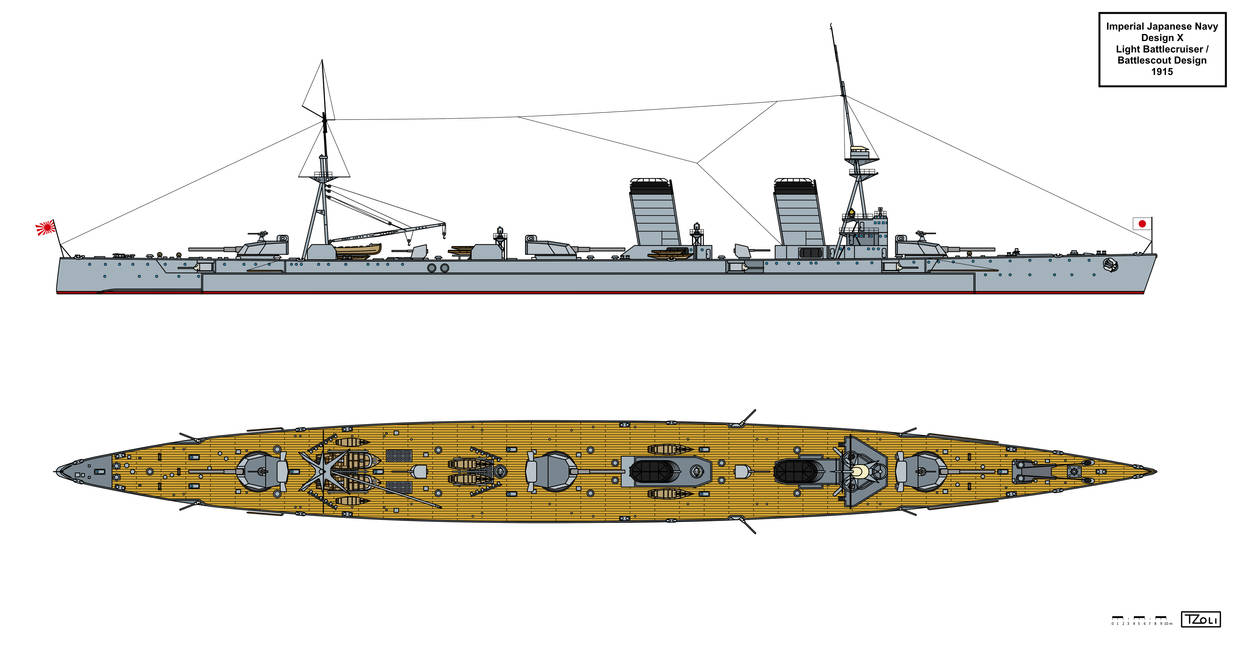
 www.deviantart.com
Source: (Hiraga number: 21710201)
www.deviantart.com
Source: (Hiraga number: 21710201)
 iiif.dl.itc.u-tokyo.ac.jp
Dimensions: 201,17 (wl) x 18,9 x 6,09 meters
iiif.dl.itc.u-tokyo.ac.jp
Dimensions: 201,17 (wl) x 18,9 x 6,09 meters
Displacement: 11.000tons (standard)
Engines: 135.000shp Steam Turbines, 4 shafts
Range: unknown
Speed: 67km/h (36knots)
Armour: 25mm Deck, 76mm Belt
Armaments:
3x1 305mm/45 Type 37 Cannons
8x1 140mm/50 Type 3 Guns
2x1 76mm/40 Type 3 DP-AA Guns
4x1 533mm Torpedo Tubes
Design X -Revised (1915/18) Large Light Cruiser or Light Battlecruiser - Some data armament changes in one of the papers found in the Yuzuru Hiraga archive shows a revised version of the Design X with 4 turrets instead of 3 and other armament changes but weirdly on a smaller hull and same displacement. Another weird thing is that Yuzuru Hiraga compared or as it seems derived it's hull or calculations from the Kuma class light cruisers which were while ordered in 1917 finished only in 1920 so a design date might be closer to 1918?
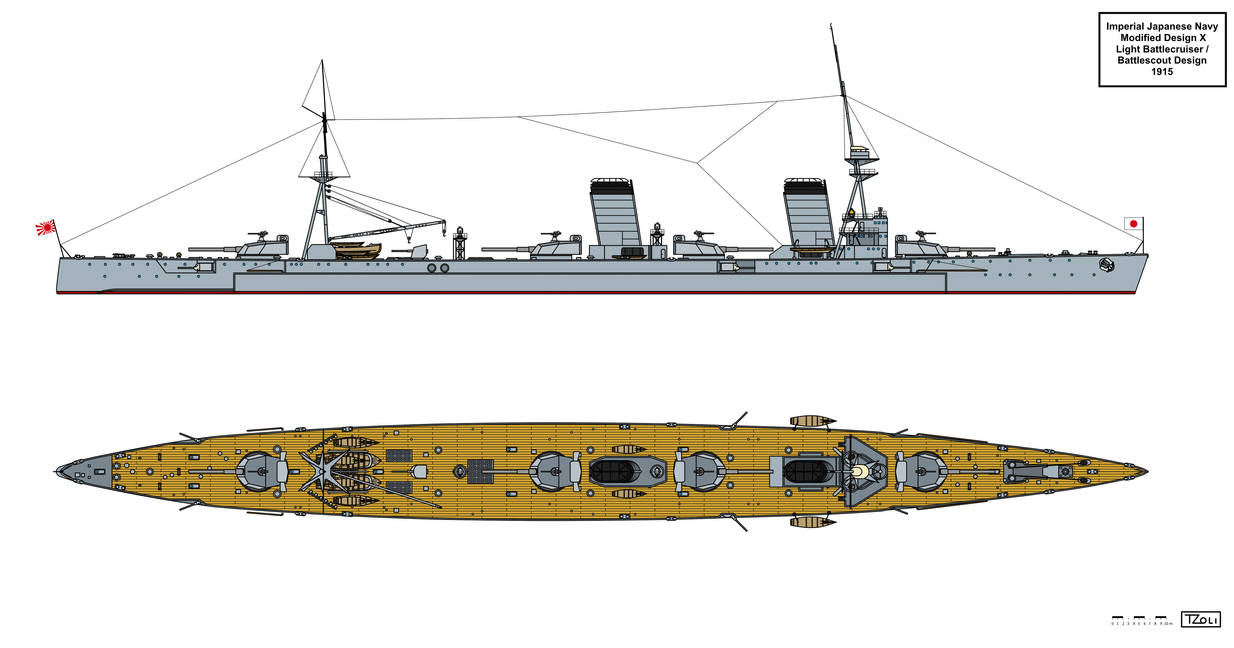
 www.deviantart.com
Source: (Hiraga number: 21710501,21711401)
www.deviantart.com
Source: (Hiraga number: 21710501,21711401)
 iiif.dl.itc.u-tokyo.ac.jp
iiif.dl.itc.u-tokyo.ac.jp
 iiif.dl.itc.u-tokyo.ac.jp
Dimensions: 199,64 (wl) x 18 x 6,06 meters
iiif.dl.itc.u-tokyo.ac.jp
Dimensions: 199,64 (wl) x 18 x 6,06 meters
Displacement: 11.000tons (standard)
Engines: 135.000shp Steam Turbines, 4 shafts
Range: unknown
Speed: 67km/h (36knots)
Armour: 25mm Deck, 76mm Belt
Armaments:
4x1 305mm/45 Type 37 Cannons
7x1 140mm/50 Type 3 Guns
4x1 76mm/40 Type 3 DP-AA Guns
6x1 533mm Torpedo Tubes
Extra:
Chichibu Class Big Gun Cruiser
While the Chichibu herself was basically a hypothetical design it should be mentioned here because it's impact both on the USN and IJN!
Some brief mention was made here many years ago:
Th Chichibu class as mentioned, was a 2-4 ship strong class believed by the USN intelligence to be built from the late 1930's. The actual data on the design was limited to displacement, speed and armament: 12-15.000tons, around 30knots and 6x 12" cannons with exact description that these are based on the German Deutschland class Heavy or Big Gun Cruisers.
The erroneous information the US gathered could be connected to multiple factors:
- Japanese misinformation and secrecy regarding their armed forces
- Inadequate information gathering from the Military Intelligence side
- False information gathering to persuade the politicians for new warship constructions
Either one or all of the above meant that the USN had information that now two hostile nations (Japan and Germany) have cruisers equipped with larger than 8" guns, a potential dangerous threat to the treaty design cruisers of the time both 6" and 8" armed ones. Hypothetical wargames and extrapolations of known data resulted that the RN and USN needed something bigger than a 10-12.000ton 8" armed cruiser to fight with these new kind of vessels. On the RN side the Deutschlands influenced the 9,2" armed cruisers designs of the 1938-40 period while for the USN both these and Chichibus resulted in developing and eventually building the Alaska class large or battlecruisers which were designed primary to fight these vessels as well as enemy 8" armed cruisers.
And now we turn back to the Imperial Japanese Navy which by late 1941 early 1942 got hold of information that the USN were ordering and building 6x large heavy cruisers with possibly larger than 8" guns. This resulted in designing a large cruiser to counter these new ship type the B-65 class with 3x3 310mm weapons. But as new and more accurate information were gathered by the Japanese the design was revised with the deck armour thickened, main armament enlarged to 3 twin 356mm cannons and likely either the allocation or drop of the quadruple 610mm torpedo tubes.
This created a sort of funny (in my opinion) construction circle: False information about a Japanese cruiser class resulting in building the Alaskas by the USN against which the Japanese designed their own cruiser to counter and to which to some extent the Soviet Stalignrads were designed and constructed as well!
Protected Cruisers:
Not found any so far except the cancelled sister ships of the Unebi and Tone classes
Light Cruisers:
Design C-19 (1912) - A primary mine-layer cruiser design offered before WW1 but not ordered.
Dimensions: 159,41 (pp) x 15,24 x 5,18 meters
Displacement: 6.000tons (standard)
Engines: 28.500shp Steam Turbines, 2 shafts
Range: 18.500km (10.000nm)
Speed: 50km/h (27knots)
Armour: none
Armaments:
4x1 152mm Guns
6x1 76mm Guns
4x1 533mm Torpedo Tubes
100x Mines
Design C-31A (1915) - A WW1 era design for a fast well armed cruiser possibly the baseline design which evolved into the Tenryu and later the Kuma/Nagara/Sendai classes or a development of the proposed 1914 large scout cruiser.
Dimensions: 161,54 (pp) x 15,85 x 5,1 meters
Displacement: 7.000tons (standard)
Engines: 106.000shp Steam Turbines, 4 shafts
Range: 9.200km (5.000nm)
Speed: 65km/h (35knots)
Armour: 25mm Deck, 76mm Belt
Armaments:
9x1 140mm Guns
1x3 533mm Torpedo Tubes
48x Mines
Design C-32 (1915) - A smaller 4.100ton cruiser, very likely part of the Tenryu design process
Dimensions: 140,21 (pp) x 13,41 x 4,11 meters
Displacement: 4.100tons (standard)
Engines: 65.000shp Steam Turbines, 4 shafts
Range: 11.000km (5.900nm)
Speed: 63km/h (34knots)
Armour: 25mm Deck, 63mm Belt
Armaments:
5x1 140mm Guns
2x3 533mm Torpedo Tubes
48x Mines
7.200ton Proposal (1916) - A well armed and armoured scout cruiser proposal first envisioned in 1914 but their slower construction time resulted their postponing to 1916. In 1916 in was re-formed into a 7.200ton cruiser and 3 ships were considered in the 8-4 and 8-6 naval programmes. This designed formed the basis of the later Furutaka class because while originally it was designed with 14cm guns in mind new 20cm guns were considered as well
Source: (Eric Lacroix - Japanese Cruisers of the Pacific War)
View: https://i.imgur.com/amHU9p9.png
Dimensions: unknown
Displacement: 7.200tons (standard)
Engines: unknown
Range: 11.000km (8.000nm)
Speed: 67km/h (36knots)
Armour: 51mm Deck, 76mm Belt
Armaments:
4x2,4x1 140mm Guns
4x2 610mm Torpedo Tubes
Tenryu-Kai type (1917) - 6 modified or improved Tenryu class cruisers were considered to be built from 1917 onward as part of the 8-4 and 8-6 naval programmes. Their designer was Teiji Kawase and only very limited info I could gather was that it's displacement would be 3.500tons compared to 3.230tons of the Tenryu class which indicate more armour somewhat more armament and larger 610mm torpedo tubes with the associated increased engine power.
Source: (Eric Lacroix - Japanese Cruisers of the Pacific War)
View: https://i.imgur.com/bUGIY8e.png
View: https://i.imgur.com/odZJ3E9.png
Furutaka Class original Design (1918) - The design process eventually leading the creation of the Furutaka class Heavy Cruisers was first started with a smaller ship evolved from the previous 7.200ton design to 8.000tons and 5-6 twin 140mm guns in a pyramidal arrangement while the AA armament only consisted of 2 single 76mm guns while the torpedo armament unchanged from the 4 twin 610mm tubes. Armour wise it was much thinner as well with the armoured box protecting only the machinery by 64mm belt and 25mm deck. Eventually based on the data of the USN's Omaha class but especially on the British Hawkins class, this design evolved into the IJN's first heavy cruiser type.
Source: (Eric Lacroix - Japanese Cruisers of the Pacific War)
View: https://i.imgur.com/6rfmXWk.png
View: https://i.imgur.com/s6NRAs5.png
5.600ton Proposal (1919) - A post war fleet escort cruiser design with good armament and very high speed. Possibly a development of the 7.200ton type though not much info is available on it.
Source: (Eric Lacroix - Japanese Cruisers of the Pacific War)
View: https://i.imgur.com/WYXdTJB.png
Dimensions: unknown
Displacement: 5.600tons (standard)
Engines: 102.800shp Steam Turbines, 4 shafts
Range: unknown
Speed: 74km/h (40knots)
Armour: unknown
Armaments:
4x2 140mm Guns
6x2 533 or 610mm Torpedo Tubes
Tenryu-Kai type (1921) - A different source provides more data on the Tenryu-Kai type cruiser putting it to 1921 and with somewhat more displacement.
Dimensions: 143 (oa) x 12,4 x 4 meters
Displacement: 4.080tons (standard)
Engines: 51.000shp Steam Turbines, 3 shafts
Range: 11.000km (8.000nm)
Speed: 61km/h (33knots)
Armour: Over Machinery: 25mm Deck, 63mm Belt
Armaments:
2x2 140mm Guns
1x1 76mm DP-AA Guns
2x2 610mm Torpedo Tubes
Design C-43 (1923) - A squadron leader cruiser proposal found in the Yuzuru Hiraga archive but likely Hiraga's own design number because C-42 was Oyodo and C-44 was the Agano-Kai. Might be connected to the earlier 5.600ton design.
Source: (Hiraga number: 21231001)
平賀譲デジタルアーカイブ · 〔C41・C42要目比較表〕/〔C43要目表〕/他4件 · 東京大学学術資産等アーカイブズ共用サーバ
Displacement: 5.600tons (standard) 7.000tons (Full load)
Engines: 42.750shp Steam Turbines, 3 shafts
Range: 9.200km (5.000nm)
Speed: 65km/h (35knots)
Armour: Over Machinery: 25mm Deck, 64mm Belt
Armaments:
4x2 140mm Guns
2x1 76mm DP-AA Guns
2x2 610mm Torpedo Tubes
100x Mines
5.000ton Proposal (1926) - A well armed true light cruiser on limited displacement and average speed, it's origins are a mystery but might be connected to the numerous Vickers export designs of the time.
Source: (Hiraga number: 21090301)
https://iiif.dl.itc.u-tokyo.ac.jp/repo/s/hiraga/document/13021264-af01-4465-9e41-5611a003d88f#?c=0&m=0&s=0&cv=0&xywh=-659,0,8261,4927
Dimensions: unknown
Displacement: 5.000tons (standard)
Engines: 60.000shp Steam Turbines, 4 shafts
Range: unknown
Speed: 59km/h (30,5knots)
Armour: unknown
Armaments:
3x3 152mm Guns
2x2 120mm DP-AA guns
2x2 533mm Torpedo Tubes
Design 1927 or C-37 (1927) - The earliest interpretation of what became the Mogami class cruisers. Yet to re-find where I've found data of it, but I seems to remember from Eric Lacroix's Japanese Cruiser book
Dimensions: 197meters (wl)
Displacement: 8.500tons (standard) 11.200tons (Full load)
Engines: 152.000shp Steam Turbines, 4 shafts
Range: unknown
Speed: unknown
Armour: 38mm Deck, 125/143mm Belt (Magazines/Machinery)
Armaments:
5x3 155mm Guns
4x1 127mm DP-AA Guns
4x3 610mm Torpedo Tubes
2x Scout Planes
Squadron Leader Design (1928) - Essentially an early interpretation of what became the Agano and Oyodo class cruisers a decade later a cruiser adequately armed and armoured with good speed to lead destroyer and submarine squadrons as well as for doing scouting duties. 6 ships were envisioned but cancelled and replaced by 4 Takao-Kai type cruisers in 1930. Though Eric Lacroix's book states "A main armament of six 50-cal 14-cm guns, in twin mounts with a high elevation" this indicates more to the 55 calibre high angle twin turret envisioned for the Kongo Replacement designs of 1928-29.
Source: (Eric Lacroix - Japanese Cruisers of the Pacific War)
View: https://i.imgur.com/IMUgWsm.png
View: https://i.imgur.com/XzB1SOs.png
Dimensions: unknown
Displacement: 5.000tons (standard)
Engines: 42.750shp Steam Turbines, 3 shafts
Range: 9.200km (5.000nm)
Speed: 65km/h (35knots)
Armour: 51mm Deck, 76mm Belt
Armaments:
3x2 140mm/50 Type 3 or 140mm/55 Type 88 Guns
2x3 610mm Torpedo Tubes
2x Scout Planes
Tone as designed (1934) - Like the Mogami originally the Tone class heavy cruisers too were designed with 155mm guns in mind, in triple turrets all forward and likely similar modified Takao or further modified Takao style brdige, but the Tomozoru incident as well as the worsening political situation meant these ships got modified Mogami bridges and the standard 20cm guns as the other IJN heavy cruisers of the time
Source: (Eric Lacroix - Japanese Cruisers of the Pacific Wa
View: https://i.imgur.com/0N586GD.png
View: https://i.imgur.com/iGFqSMz.png
Squadron Leader Design (1937) - The immediate precursor of the Agano class cruisers but on a smaller displacement and with Oyodo style armament and better heavy AA. 5 such ships were considered to be built in the Maru 3 programme but voted down by the Diet.
Source: (Eric Lacroix - Japanese Cruisers of the Pacific War)
Dimensions: unknown
Displacement: 5.000tons (standard)
Engines: unknown
Range: 13.000km (7.000nm)
Speed: 67km/h (36knots)
Armour: 100mm Belt
Armaments:
2x3 155mm/60 Type 90 Guns
4x2 76mm/60 Type 98 DP-AA Guns
3x2 25mm/60 Type 96 AA guns
2x4 610mm Torpedo Tubes
1x Seaplane
Kuma Class Original Torpedo Cruiser Conversion proposal (1938) - As to be compatible with the new night fighting doctrine the IJN experimenting with, 3 of the 5 Kuma class cruisers were to be converted into a Torpedo Cruiser with very heavy torpedo armament to destroy or scatter entire enemy fleets. The conversion was actually done but to a modified design and for only 2 ships. The original proposal had these armaments for the cruisers:
4x2 127mm/40 Type 89 DP-AA guns, 4x2 25mm/60 Type 96 AA guns and 11x quadruple 610mm Torpedo Launchers: 5 per side and 1 one the centreline! The production bottleneck for the torpedos and their launchers as well as the 127mm DP-AA guns meant that the revised design only applied to two ships with most of their original armament remained impact with reduced torpedo launcher number.
Design C-39 (1938) - The first known preliminary design leading to the Agano class light cruisers with different engine power, longer range and slightly smaller displacement, different torpedo arrangement and with two funnels.
Source: (Eric Lacroix - Japanese Cruisers of the Pacific War)
Dimensions: 162 (pp) x 173 (wl) x 174,5 (oa) x 15,2 x 5,6 meters
Displacement: 6.585tons (standard) 7.800tons (Full load)
Engines: 112.000shp Steam Turbines, 4 shafts
Range: 14.800km (8.000nm)
Speed: 67km/h (36knots)
Armour: 20mm Deck, 55/60mm Belt (Magazines/Machinery)
Armaments:
3x2 152mm Type 43 Guns
2x2 76mm/60 Type 98 DP-AA Guns
2x3 25mm/60 Type 96 AA guns
2x4 610mm Torpedo Tubes
18x Depth Charges
2x Seaplanes
Design C-39 Modified (1938) - After the baseline C-39 design was made some modifications were made on the design mostly to the hull length and reduced engine power:
Source: (Eric Lacroix - Japanese Cruisers of the Pacific War)
Dimensions: 170 (wl) x 15,2 x 5,6 meters
Displacement: 6.450tons (standard) 7.600tons (Full load)
Engines: 99.000shp Steam Turbines, 4 shafts
Range: 14.800km (8.000nm)
Speed: 65km/h (35knots)
Armour: 20mm Deck, 55/60mm Belt (Magazines/Machinery)
Armaments:
3x2 152mm Type 43 Guns
2x2 76mm/60 Type 98 DP-AA Guns
2x3 25mm/60 Type 96 AA guns
2x4 610mm Torpedo Tubes
18x Depth Charges
2x Seaplanes
Oyodo Preliminary Design 1 (1938) - One of the design studies considered for the Submarine squadron leader type cruisers of the Oyodo class. Heavy DP-AA guns 2 forward and two on the sides, aircraft capacity for 6-8 planes and two catapults
Source: (Eric Lacroix - Japanese Cruisers of the Pacific War)
Dimensions: unknown
Displacement: 5.000tons (standard)
Engines: unknown
Range: 18.500km (10.000nm)
Speed: 67km/h (36knots)
Armour: unknown
Armaments:
4x2 127mm/40 Type 89 DP-AA Guns
6x3 25mm/60 Type 96 AA guns
6-8x Seaplanes, likely E16A Paul types
Oyodo Preliminary Design 2 (1938) - A refined version of the previous design where the catapults located at almost side by side.
Source: (Eric Lacroix - Japanese Cruisers of the Pacific War)
Dimensions: unknown
Displacement: 6.600tons (standard)
Engines: unknown
Range: 18.500km (10.000nm)
Speed: 67km/h (36knots)
Armour: unknown
Armaments:
4x2 127mm/40 Type 89 DP-AA Guns
6x3 25mm/60 Type 96 AA guns
6x Seaplanes, likely E16A Paul types
Oyodo Preliminary Design 3 (1938) - The basic design which developed further into the Oyodo class almost the same as the original just different aircraft handling facilities and shorter range but with the long 45m catapult aft.
Source: (Eric Lacroix - Japanese Cruisers of the Pacific War)
Dimensions: unknown
Displacement: 8.200tons (standard) 9.800tons (Full load)
Engines: 110.000shp Steam Turbines, 4 shafts
Range: 18.500km (10.000nm)
Speed: 65km/h (35knots)
Armour: unknown
Armaments:
2x3 155mm/60 Type 90 Guns
4x2 100mm/60 Type 98 DP-AA Guns
8x2 25mm/60 Type 96 AA guns
6x Seaplanes, likely E16A Paul types
Design C-44 Agano Kai (1941) - An improved or modified Agano with 4 main turrets and higher speed. 7 units ordered in 1941 to replace the aging 5.500ton type (Kuma, Nagara, Sendai) cruisers
Source: (Eric Lacroix - Japanese Cruisers of the Pacific War)
Dimensions: 175 (pp) x 184 (wl) x 16,4 x 5,9 meters
Displacement: 8.250tons (standard) 9.670tons (Full load)
Engines: 153.000shp Steam Turbines, 4 shafts
Range: 11.600km (6.300nm)
Speed: 70km/h (38knots)
Armour: 20mm Deck, 55/60mm Belt (Magazines/Machinery)
Armaments:
4x2 152mm Type 43 Guns
4x2 76mm/60 Type 98 DP-AA Guns
3x3 25mm/60 Type 96 AA guns
2x4 610mm Torpedo Tubes
2x Seaplanes
Armoured Cruisers:
Only found one so far, the First Class Armoured Cruiser Design from 1904/05. A modern looking 6" armed cruiser with most of its guns in twin circular turrets and often seen accompanied with the First class battleship drawing from the same year. The origins are not entirely clear but likely the result of the Battle of Tsushima. Drawings were found in the Hiraga archive as well as in Japanese books and magazines.
Source: (Battleships and Battle Cruisers of the IJN by Ishibashi Takao)
Source: (Hiraga number: 20200201)
平賀譲デジタルアーカイブ · Proposed First Class Cruiser. · 東京大学学術資産等アーカイブズ共用サーバ
Displacement: 12.000tons (standard)
Engines: unknown
Range: unknown
Speed: 41km/h (22knots)
Armour: 51mm Deck, 51mm Slopes, 152mm Belt
Armaments:
8x2,4x1 152mm Guns
6x1 120 Guns
4x1 457mm Torpedo Tubes
Heavy Cruisers:
Design C-41 (1923) - A heavy cruiser proposal found in the Yuzuru Hiraga archive but likely Hiraga's own design number because C-41 was actually the Agano class. Might be connected to the Myoko class design process. Very heavy displacement compared to armour and armament.
Source: (Hiraga number: 21231001)
平賀譲デジタルアーカイブ · 〔C41・C42要目比較表〕/〔C43要目表〕/他4件 · 東京大学学術資産等アーカイブズ共用サーバ
Displacement: 14.000tons (standard) 18.000tons (Full load)
Engines: 140.000shp Steam Turbines, 4 shafts
Range: unknown
Speed: 68km/h (36,5knots)
Armour: 25/47mm Deck, 51/102mm Belt (Magazines/Machinery)
Armaments:
4x2 200mm/50 Type 3 Guns
2x1 120mm/45 Type 10 DP-AA Guns
2x4 610mm Torpedo Tubes
Design C-42 (1923) - Another heavy cruiser proposal found in the Yuzuru Hiraga archive but likely Hiraga's own design number because C-42 was actually the Oyodo class. Might be connected to the Myoko class design process. Smaller and slightly slower than the previous proposal
Source: (Hiraga number: 21231001)
平賀譲デジタルアーカイブ · 〔C41・C42要目比較表〕/〔C43要目表〕/他4件 · 東京大学学術資産等アーカイブズ共用サーバ
Displacement: 12.000tons (standard) 15.200tons (Full load)
Engines: 125.000shp Steam Turbines, 4 shafts
Range: 14.800km (8.000nm)
Speed: 67km/h (36knots)
Armour: 25/47mm Deck, 51/102mm Belt (Magazines/Machinery)
Armaments:
4x2 200mm/50 Type 3 Guns
2x1 120mm/45 Type 10 DP-AA Guns
2x4 610mm Torpedo Tubes
Myoko Preliminary Design (1924) - Possibly connected to the Myoko design process 20cm turret calculations connected to the Myoko papers shows Hiraga played with the ideas of well armoured triple and quadruple turrets on a slightly shorter hull and thinner armour
Source: (Hiraga number: 21231001)
平賀譲デジタルアーカイブ · 妙高 · 東京大学学術資産等アーカイブズ共用サーバ
Displacement: 10.000tons (standard)
Engines: unknown
Range: unknown
Speed: unknown
Armour: 38mm Deck, 89mm Belt
Armaments:
4x3 or 3x4 200mm/50 Type 3 Guns
2x1 120mm/45 Type 10 DP-AA Guns
2x2 13,2mm AA Guns
2x Seaplanes
Myoko Preliminary Design (1924) - One of the designs considered for the Myoko class, almost identical to the as built class but with longer range.
Source: (Hiraga number: 22160101, 201, 301)
平賀譲デジタルアーカイブ · 軍艦妙高・那智一般艤装図 大正12.3 · 東京大学学術資産等アーカイブズ共用サーバ
平賀譲デジタルアーカイブ · 壱万噸・拾参万馬力軽巡大体図 大正12.3 · 東京大学学術資産等アーカイブズ共用サーバ
平賀譲デジタルアーカイブ · 壱万噸・拾参万馬力軽巡大体図 大正12.3 · 東京大学学術資産等アーカイブズ共用サーバ
Displacement: 10.000tons (standard)
Engines: 130.000shp Steam Turbines, 4 shafts
Range: 14.800km (8.000nm)
Speed: 67km/h (36knots)
Armour: unknown
Armaments:
5x2 200mm/50 Type 3 Guns
4x1 120mm/45 Type 10 DP-AA Guns
2x2 13,2mm AA Guns
2x Seaplanes
IJN Haguro upgun proposal (1933) - According to some Japanese sources and the Japanese Wiki there was a new 20,3cm cannon under development in the late 1920's early 1930's which was expected to be mounted on new cruisers and would had been comparable to the USN 8"/55 cannons. This weapon would had been a longer /55 calibre one and would had been first tested on IJN Haguro and to be mounted on the Takaos but due to budgetary issues this new weapon did not enter service.
Source: (Japanese Wikipedia)
Takao-Kai type Heavy Cruiser (1929/30) - Soon after the Takao class cruisers ordered a new follow-up design was considered but development was postponed until the end of decade. This was unlucky because the 1st London Naval Treaty was held in 1929 with its ratification in 1930 meant all new heavy cruiser construction had to be halted as the nations reached their quota (And the RN could not keep with them...) Hence the very limited info available on this design. Only some basic requirements were set before the programme cancelled which included better heavy AA likely twin instead of single 127mm/40 Type 89 DP-AA guns and improved armour likely 140mm Magazine belt and the usual 5 twin 20cm guns which might had been the new /55 calibre ones as well. We could expect that the Tower like bridge would had been modified similar to what first proposed for the Mogami class cruisers. Though knowing how the original Takaos were overweight by 1350tons from the set 10.000tons this improved version we could had expected even more!
Source: (Eric Lacroix - Japanese Cruisers of the Pacific War)
Tone-Kai type Heavy Cruiser (1938/39) - At the 1938 revised Maru 4 programme, two modified Tone type cruisers were considered to be built to form a homogeneous squadron with the other two Tones. Not much is known about this design except that it was based on the Tone class but with substantial more displacement of 13.000tons standard instead of the 11.200tons of the original Tones which might indicate better armour and engine power and command facilities.
Source: (Eric Lacroix - Japanese Cruisers of the Pacific War), Japanese Wiki
Ibuki Class Heavy Cruiser Design C-46 "Torpedo Modification Proposal" (1942)- While the Ibuki class IJN Ibuki and Ikoma hull numbers 300 and 301 were known cruiser based on the Suzuya, there was a proposal to change these heavy cruisers into more potent torpedo platforms. Though the description is rather vague how the torpedo launchers would had been placed, it was said that the original 4 quad launchers either to be replaced or even strengthened by 5 quintuple launchers, 2 per side one one centreline in place of the Aircraft handling facilities even deleting the Catapults themselves. This would had been provided a great deal of torpedo firepower rivaling that of the Kitakami and Oi's conversions with either 15 or 23 tubes per side!
Source: (Eric Lacroix - Japanese Cruisers of the Pacific War)
AA Cruisers:
Tenryu CLAA Conversion proposal 1 - In 1936, plans were drawn up to convert the 2 Tenryu class light cruisers into Anti-Aircraft ships akin to the C class in the Royal Navy and to improve these old small cruisers fighting capabilities. The conversion envisioned the replacement of the the entire armament by:
4x2 127mm/40 Type 89 DP-AA guns, 4x3 25mm/60 Type 96 AA guns, 2x3 533mm Torpedo Tubes, 36x Depth Charges. Due to more pressing issues as well as budgetary restrictions these conversions did not followed this time.
Source: (Eric Lacroix - Japanese Cruisers of the Pacific War)
Tenryu CLAA Conversion proposal 2 - In 1938, new revised plans were drawn up to convert again the 2 Tenryu class light cruisers into Anti-Aircraft ships, this time the armament was changed to more modern weapons:
4x2 76mm/60 Type 98 DP-AA guns, 4x3 25mm/60 AA guns, 2x3 533mm Torpedo Tubes, 36x Depth Charges. Again due to budgetary restrictions these conversions did not followed and seems to be abandoned altogether.
Source: (Eric Lacroix - Japanese Cruisers of the Pacific War)
Kuma CLAA Conversion proposal - In 1938, next to the Torpedo cruiser conversion proposal, Anti-Aircraft conversion too was envisioned for all the Kuma class ships akin to the C class in the Royal Navy. The conversion envisioned the replacement of the the entire armament by:
2x2 100mm/60 Type 98 DP-AA guns, 4x3 25mm/60 Type 96 AA guns, 4x2 533mm Torpedo Tubes, 36x Depth Charges. Due to more pressing issues as well as budgetary restrictions these conversions did not followed this time.
Source: (Eric Lacroix - Japanese Cruisers of the Pacific War)
Oyodo CLAA Conversion proposal - In late 1941 early 1942 due to the ever increasing effectiveness of aircrafts it was proposed to convert the then under construction Type C (Oyodo class) cruisers into heavy AA ships with an unparalleled armament of 12x twin 10cm AA guns! The admiralty seems to be not too fond of the idea believing their carriers could protect the fleet not to mention each such cruisers would eat up as much as 3 Akizuki class Destroyer gun mounts and which was a bottleneck in AA gun construction for the IJN. This design became known as the Japanese Atlanta and most sources show the 3-2/2-3 arrangement version of the design.
Source: (Eric Lacroix - Japanese Cruisers of the Pacific War)
Dimensions: 180 (pp) x 189,7 (wl) x 192,1 (oa) x 16,6 x 5,95 meters
Displacement: 7.150tons (standard) 9.200tons (Full load)
Engines: 110.000shp Steam Turbines, 4 shafts
Range: 13.000km (7.000nm)
Speed: 64km/h (34,5knots)
Armour: 30/50mm Deck, 60/75mm Belt
Armaments:
12x2 100mm/60 Type 98 DP-AA
6x3 25mm/60 Type 96 AA guns
2x4 610mm Torpedo Tubes
IJN Suzuya AA Conversion Proposal (1942) - After the battle of Midway in which Mikuma sunk and Mogami was heavily damaged only 3 operational Mogami class cruisers remained in service. Between late 1942 and early 1943, while Mogami was underwent repair and conversion into an aviation cruiser to increase the fleet's scouting capability, plans were drawn up to convert both Suzuya and Kumano into Anti-aircraft cruisers. The plans included the replacement of all the main 20cm twin turrets to twin 12,7cm DP-AA mounts as well as increase of light AA gun armament. Though original plans included to convert both of the two fully operational cruisers to Anti-aircraft ships, most likely to wartime shortage of 12,7cm guns as well as suitable dockyard capacity, Suzuya would only got her aft guns replaced by the mentioned AA weaponry while still able to provide the same firepower as the Furutaka and Aoba classes.
Source: (Eric Lacroix - Japanese Cruisers of the Pacific War)
IJN Kumano AA Conversion Proposal (1942) - While IJN Suzuya would only got half the AA gun replacement that was proposed, IJN Kumano could had received the full conversion creating a potent AA platform rivalling even that of the USN's Atlanta class AA light cruisers. Other changes likely would be included the replacement of the main gun rangefinder with High-angle one as well as more Machine-gun director towers for controlled AA fire.
Source: (Eric Lacroix - Japanese Cruisers of the Pacific War)
Design C-45 (1942) - Pure Anti-Aircraft cruiser designs from start envisioned as Akizuki class flotilla leaders, 4 ships were ordered one for each surface battle group and essentially enlarged Akizukis with seaplane facilities on board. Artists tend to describe them as Aganos with 10cm main guns.
Source: (Eric Lacroix - Japanese Cruisers of the Pacific War), Japanese Wiki
815号型軽巡洋艦 - Wikipedia
Displacement: 5.800tons (standard) 7.150tons (Full load)
Engines: 103.000shp Steam Turbines, 4 shafts
Range: 13.000km (7.000nm)
Speed: 63km/h (34knots)
Armour: 50mm Deck, 50mm Belt
Armaments:
4x2 100mm/60 Type 98 DP-AA
6x3 25mm/60 Type 96 AA guns
100x Depth Charges
2x Seaplanes
Others:
Design X (1915/18) Large Light Cruiser or Light Battlecruiser - Found in the Hiraga archive, drawings of a long slim and fast cruiser with single 305mm cannons, clearly inspired by the British Courageous class. This Japanese design is more lightly armorued than her British cousins but would had been less costly as well due to the smaller size.

IJN Design X Light Battlecruiser Design by Tzoli on DeviantArt
平賀譲デジタルアーカイブ · "X"LIGHT CRUISER · 東京大学学術資産等アーカイブズ共用サーバ
Displacement: 11.000tons (standard)
Engines: 135.000shp Steam Turbines, 4 shafts
Range: unknown
Speed: 67km/h (36knots)
Armour: 25mm Deck, 76mm Belt
Armaments:
3x1 305mm/45 Type 37 Cannons
8x1 140mm/50 Type 3 Guns
2x1 76mm/40 Type 3 DP-AA Guns
4x1 533mm Torpedo Tubes
Design X -Revised (1915/18) Large Light Cruiser or Light Battlecruiser - Some data armament changes in one of the papers found in the Yuzuru Hiraga archive shows a revised version of the Design X with 4 turrets instead of 3 and other armament changes but weirdly on a smaller hull and same displacement. Another weird thing is that Yuzuru Hiraga compared or as it seems derived it's hull or calculations from the Kuma class light cruisers which were while ordered in 1917 finished only in 1920 so a design date might be closer to 1918?

IJN Design X Light Battlecruiser Design 2 by Tzoli on DeviantArt
平賀譲デジタルアーカイブ · 〔Light Cruiser 案〕 · 東京大学学術資産等アーカイブズ共用サーバ
平賀譲デジタルアーカイブ · 〔整理封筒:このID(4桁数字)の資料を一括して入れていたもの〕 · 東京大学学術資産等アーカイブズ共用サーバ
Displacement: 11.000tons (standard)
Engines: 135.000shp Steam Turbines, 4 shafts
Range: unknown
Speed: 67km/h (36knots)
Armour: 25mm Deck, 76mm Belt
Armaments:
4x1 305mm/45 Type 37 Cannons
7x1 140mm/50 Type 3 Guns
4x1 76mm/40 Type 3 DP-AA Guns
6x1 533mm Torpedo Tubes
Extra:
Chichibu Class Big Gun Cruiser
While the Chichibu herself was basically a hypothetical design it should be mentioned here because it's impact both on the USN and IJN!
Some brief mention was made here many years ago:
Th Chichibu class as mentioned, was a 2-4 ship strong class believed by the USN intelligence to be built from the late 1930's. The actual data on the design was limited to displacement, speed and armament: 12-15.000tons, around 30knots and 6x 12" cannons with exact description that these are based on the German Deutschland class Heavy or Big Gun Cruisers.
The erroneous information the US gathered could be connected to multiple factors:
- Japanese misinformation and secrecy regarding their armed forces
- Inadequate information gathering from the Military Intelligence side
- False information gathering to persuade the politicians for new warship constructions
Either one or all of the above meant that the USN had information that now two hostile nations (Japan and Germany) have cruisers equipped with larger than 8" guns, a potential dangerous threat to the treaty design cruisers of the time both 6" and 8" armed ones. Hypothetical wargames and extrapolations of known data resulted that the RN and USN needed something bigger than a 10-12.000ton 8" armed cruiser to fight with these new kind of vessels. On the RN side the Deutschlands influenced the 9,2" armed cruisers designs of the 1938-40 period while for the USN both these and Chichibus resulted in developing and eventually building the Alaska class large or battlecruisers which were designed primary to fight these vessels as well as enemy 8" armed cruisers.
And now we turn back to the Imperial Japanese Navy which by late 1941 early 1942 got hold of information that the USN were ordering and building 6x large heavy cruisers with possibly larger than 8" guns. This resulted in designing a large cruiser to counter these new ship type the B-65 class with 3x3 310mm weapons. But as new and more accurate information were gathered by the Japanese the design was revised with the deck armour thickened, main armament enlarged to 3 twin 356mm cannons and likely either the allocation or drop of the quadruple 610mm torpedo tubes.
This created a sort of funny (in my opinion) construction circle: False information about a Japanese cruiser class resulting in building the Alaskas by the USN against which the Japanese designed their own cruiser to counter and to which to some extent the Soviet Stalignrads were designed and constructed as well!
Last edited by a moderator:

